Working in motorsport requires passion, dedication and a certain amount of insanity! Hours are long and depending on the role, it can often mean spending more time on the road than at home with your family, at least during race season and testing.
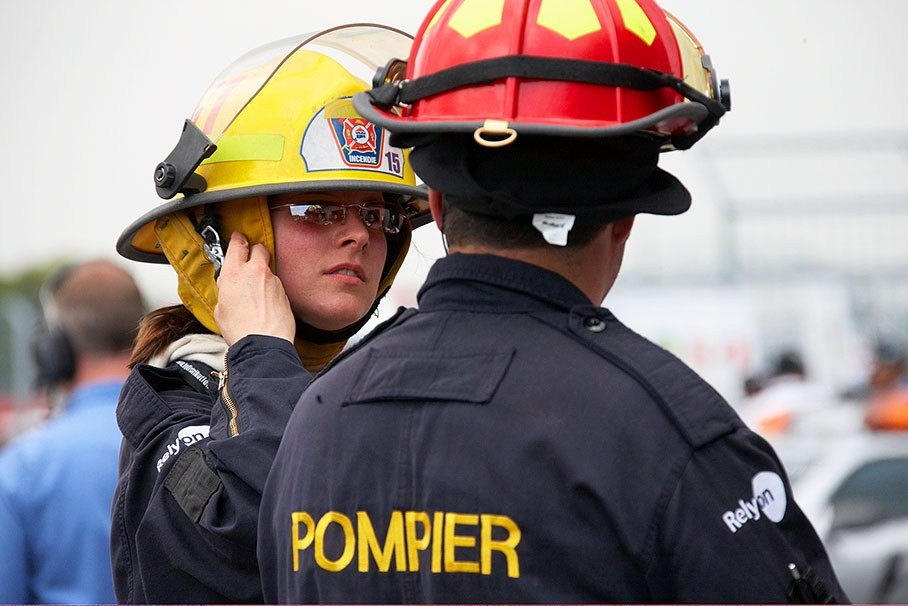
Marshals in Canada, Montreal, in July 2008. Photo by Rainer Schlegelmilch.
Even for those who are at the operational end of motorsport such as event staff and safety operatives, the industry is gruelling and seriously hard work.
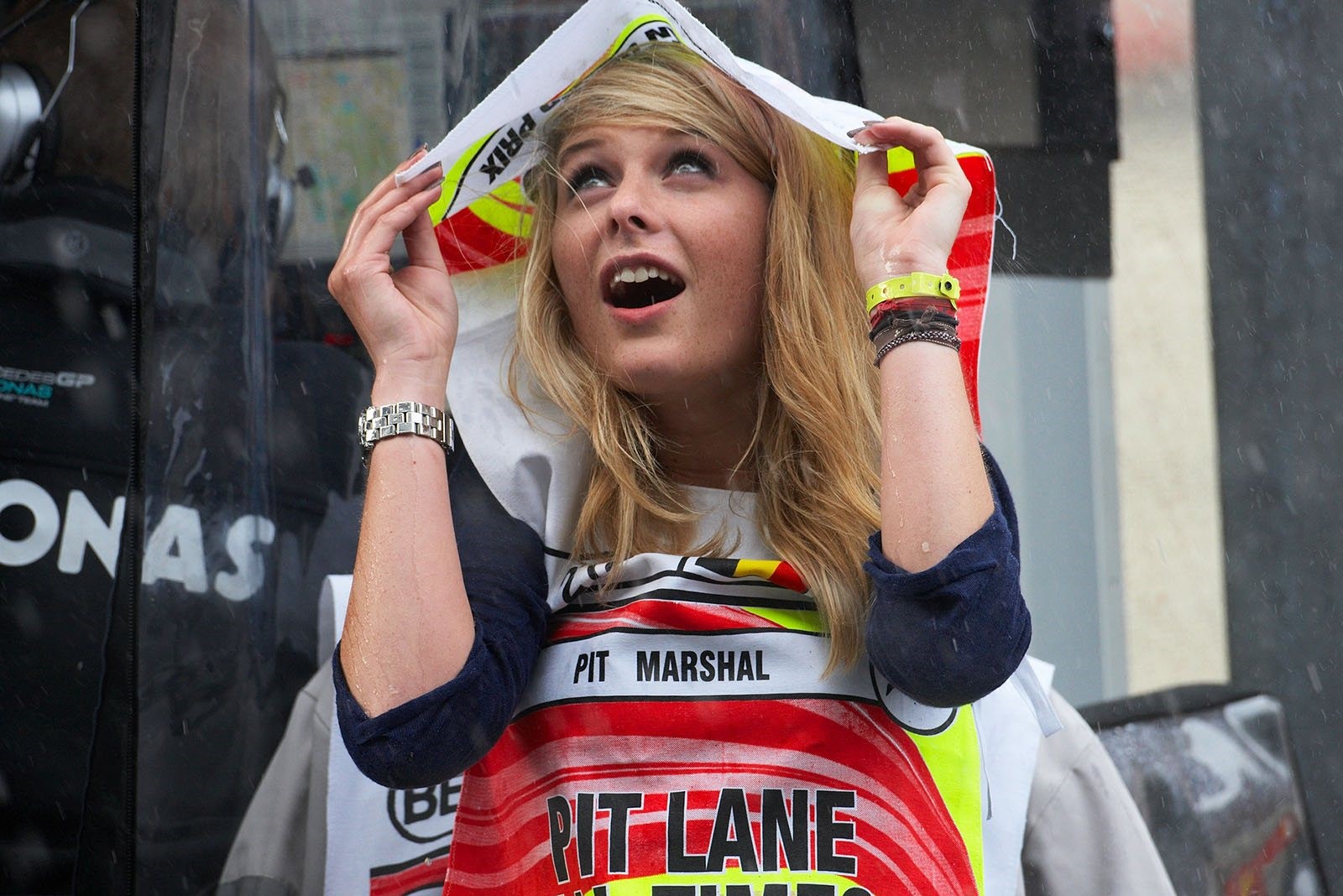
A Belgian flower grows in the pitlane. Spa-Francorchamps, December 2011. Photo by Rainer Schlegelmilch.
So why on earth do people dedicate their time for free? Some may say for the love of the sport, the thrill of the race, a front row seat to the excitement of the track. In truth, many motorsport volunteers give up their own free time to make the sport safer.
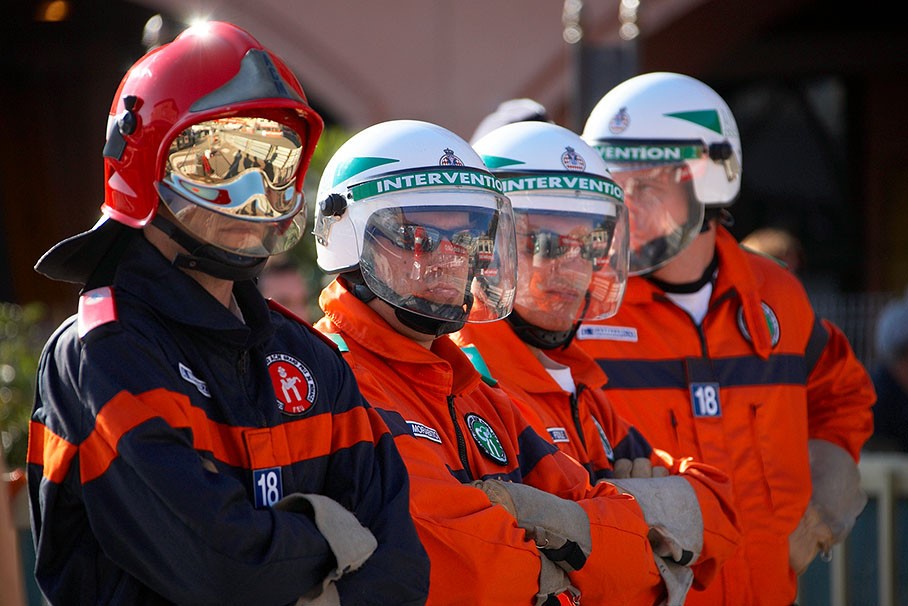
Marshals stand in line alongside the track at Monte Carlo in June 2010. Photo by Rainer Schlegelmilch.
May we introduce you to the often unsung heroes of motorsport, the weekend warriors making a difference out there ….. the Marshals.

Shanghai, Cina, in 2007. Photo by Rainer Schlegelmilch.
When people think about working in motorsport, they often only think about the glamour of Formula 1 – the highly paid driver and their passionate pit crew, all flying around the world first-class.
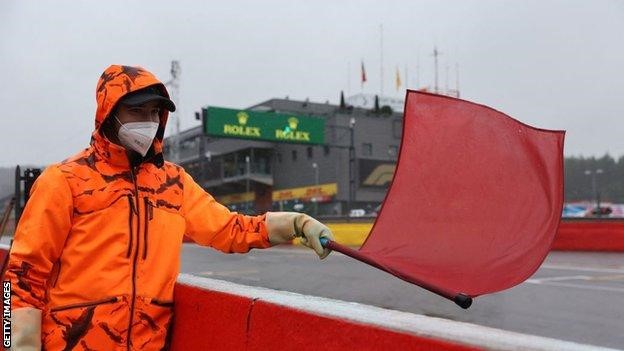
2021 Belgian GP at Spa Francorchamps.
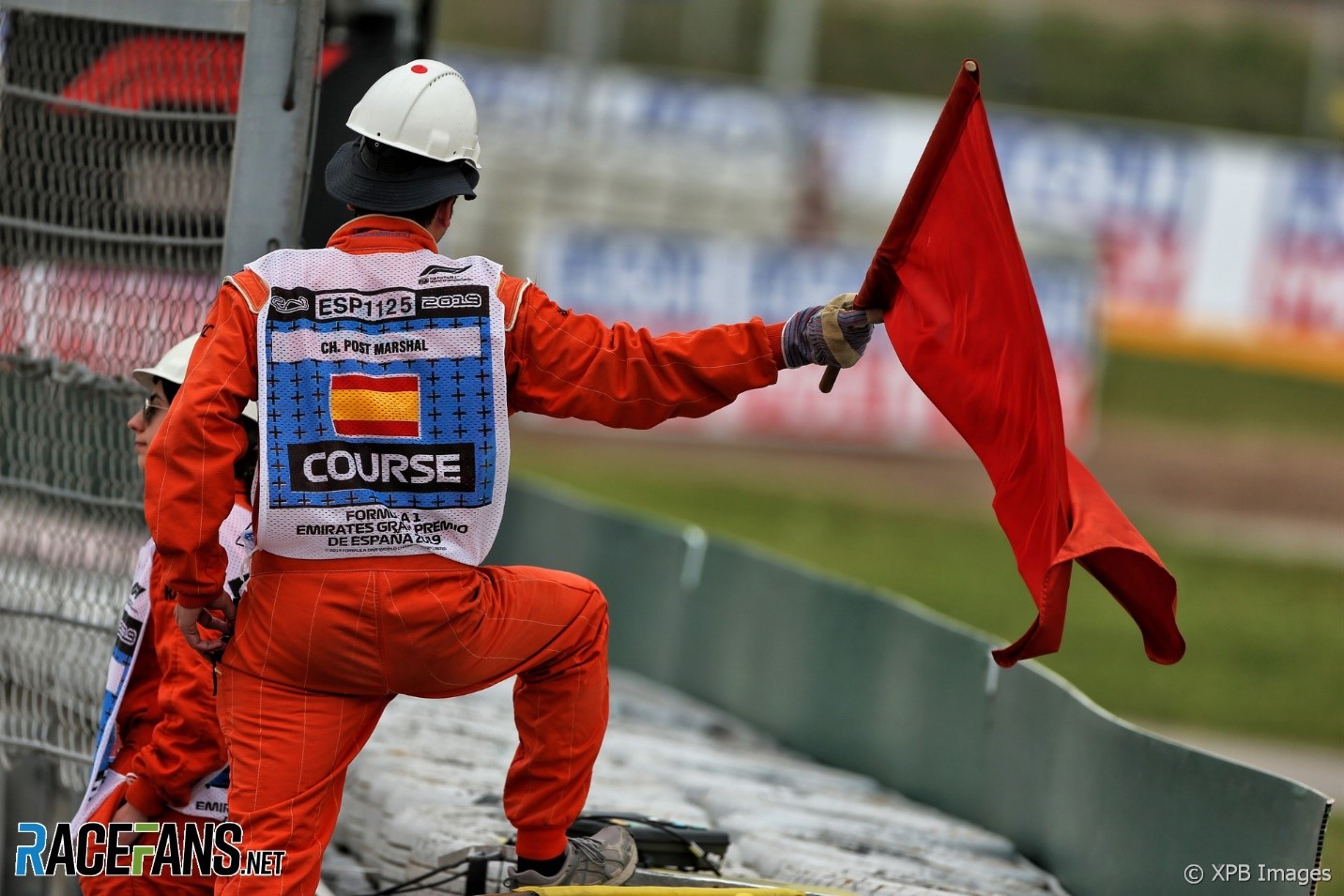
Marshal, Circuit de Catalunya, 2019.
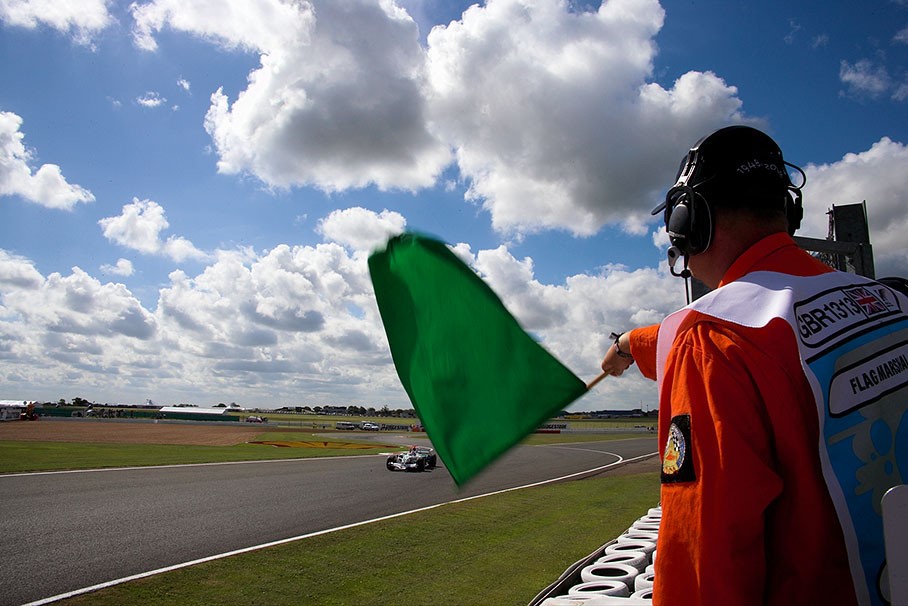
A marshal at Silverstone, Great Britain, in September 2008. Photo by Rainer Schlegelmilch.
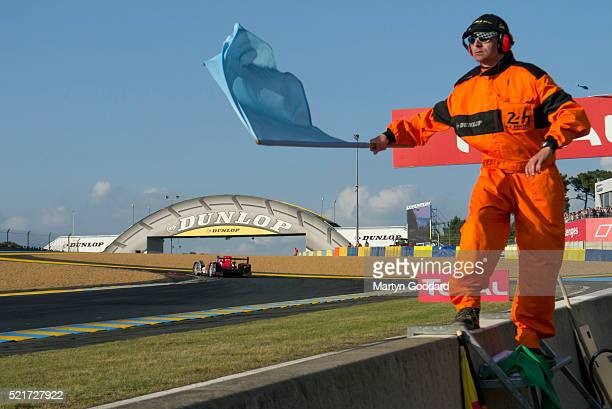
Flag marshal waving blue flag at the approach to Dunlop chicane. 2014 24 Hours of Le Mans. Credit Stock Photo.
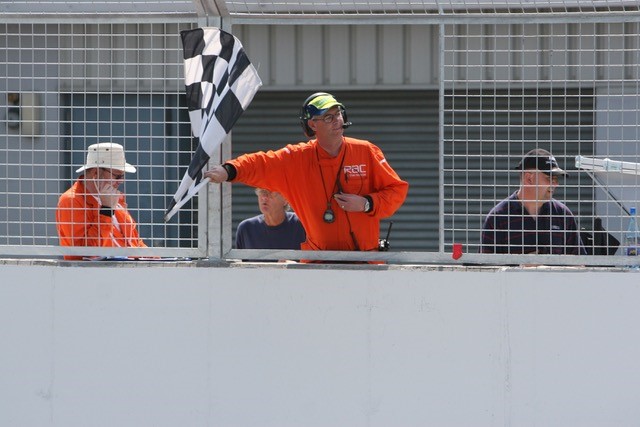
People don’t often think about the people who dedicate themselves to the mechanics of the sport itself. Quite simply, without marshals, there could be no motorsport.
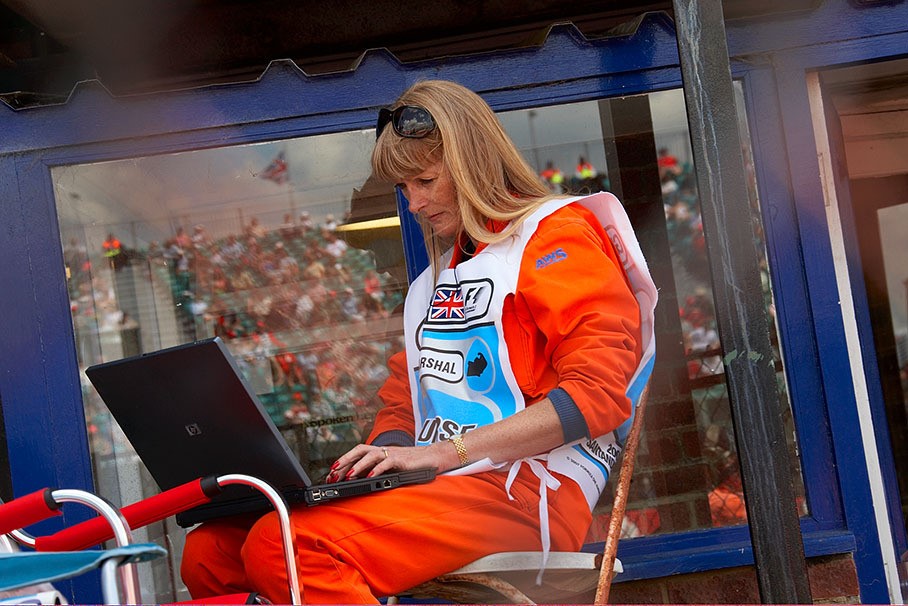
A marshal at Silverstone in September 2008. Photo by Rainer Schlegelmilch.
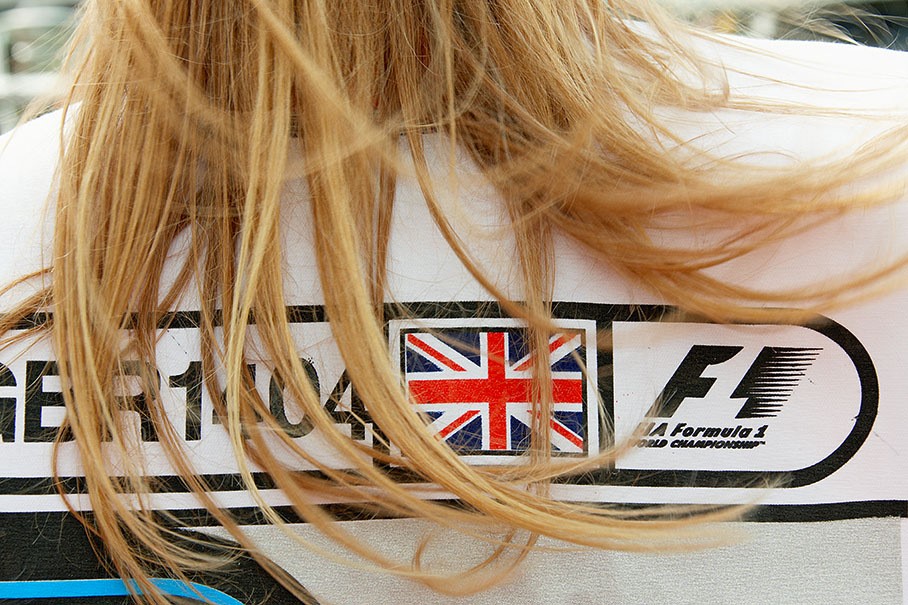
A female marshal guards the pitlane at Silverstone in August 2009. Photo by Rainer Schlegelmilch.
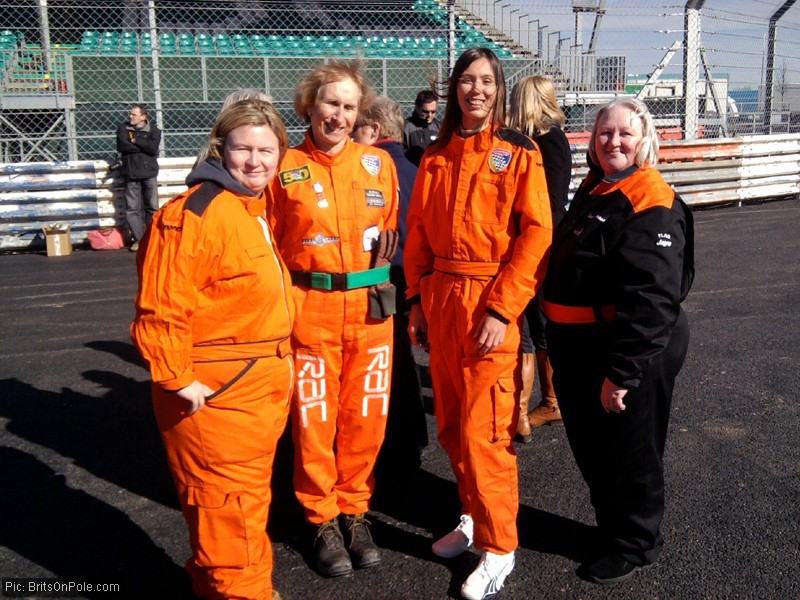
The marshals at Silverstone in 2010, Jean Whitebread on the right.
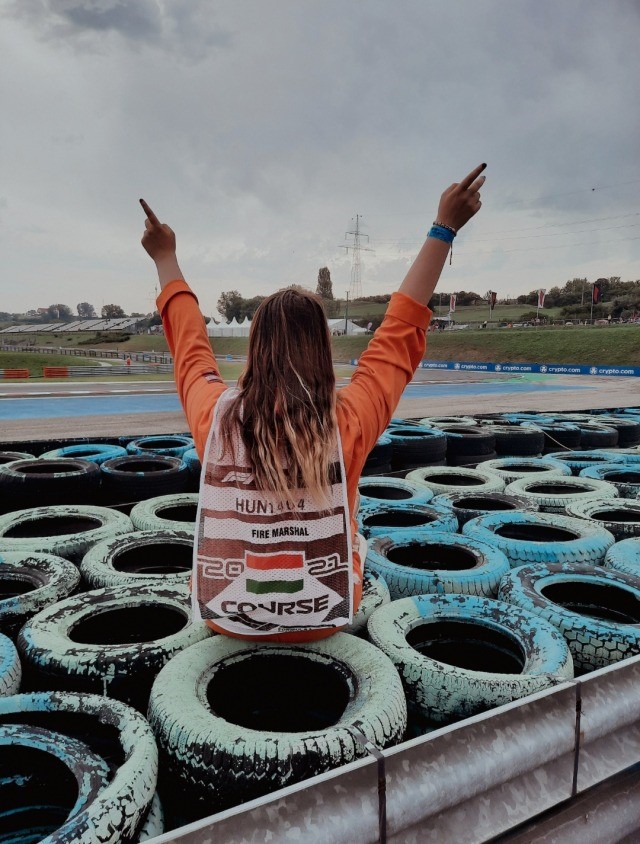
Track-side marshals are the first on the scene in the event of a race incident and as strange as it may sound, you don’t need any prior medical skills or training to be able to do the job.
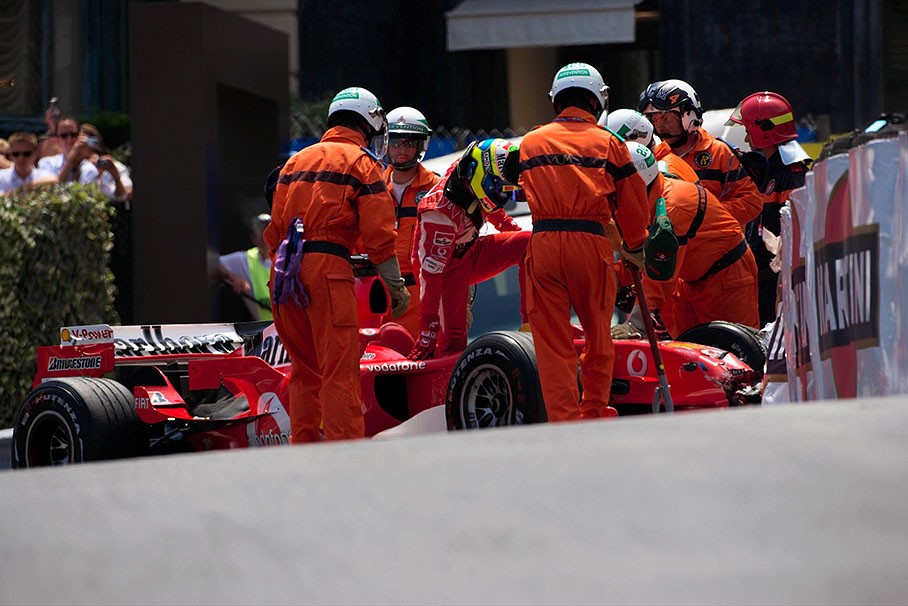
Felipe Massa pushed his red lady too hard at Monaco in July 2006. Photo by Rainer Schlegelmilch.

Webber escaping his burning car at Monaco in July 2006. Photo by Rainer Schlegelmilch.
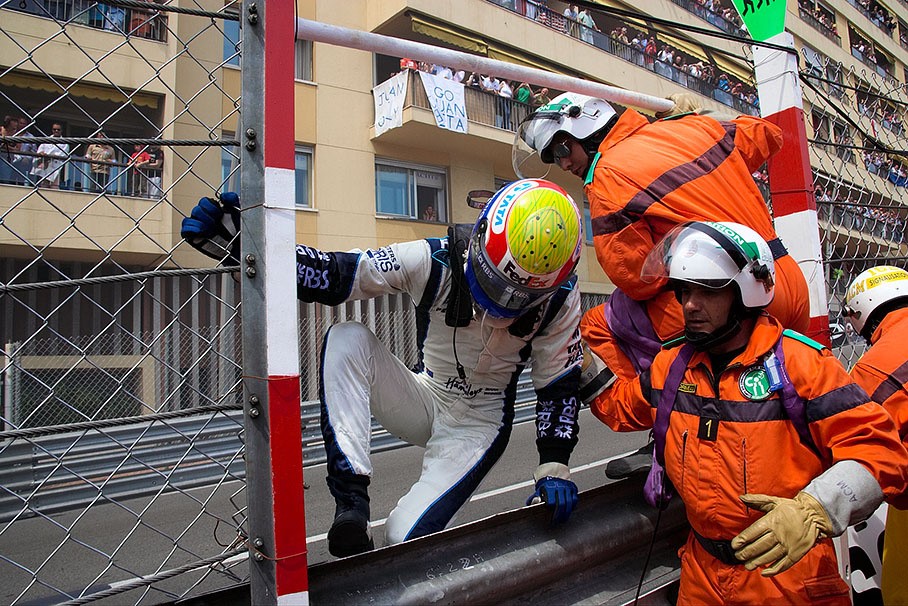
Webber jumping over the barrier after retiring with exhaust problems at Monaco in July 2006. Photo by Rainer Schlegelmilch.
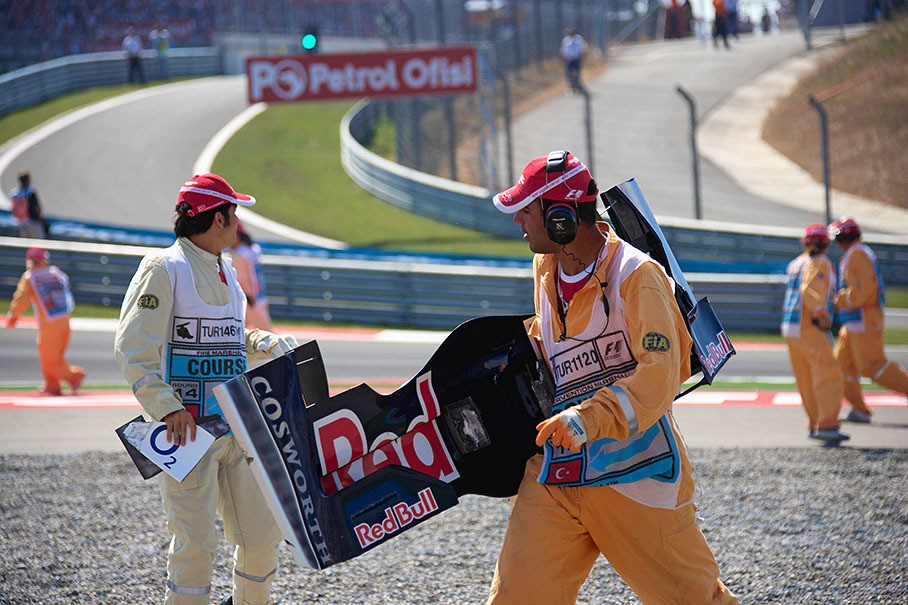
Turkish track marshal collecting Speeds front wing which slashed Raikkonen's rear tyre at Istanbul in 2006. Photo by Rainer Schlegelmilch.

Sakon Yamamoto's Honda being pushed out of the gravel by helpful Turkish hands at Istanbul in 2006. Photo by Rainer Schlegelmilch.
Most training is offered on a hands-on basis where you learn from people who have been protecting drivers, teams and spectators for years.
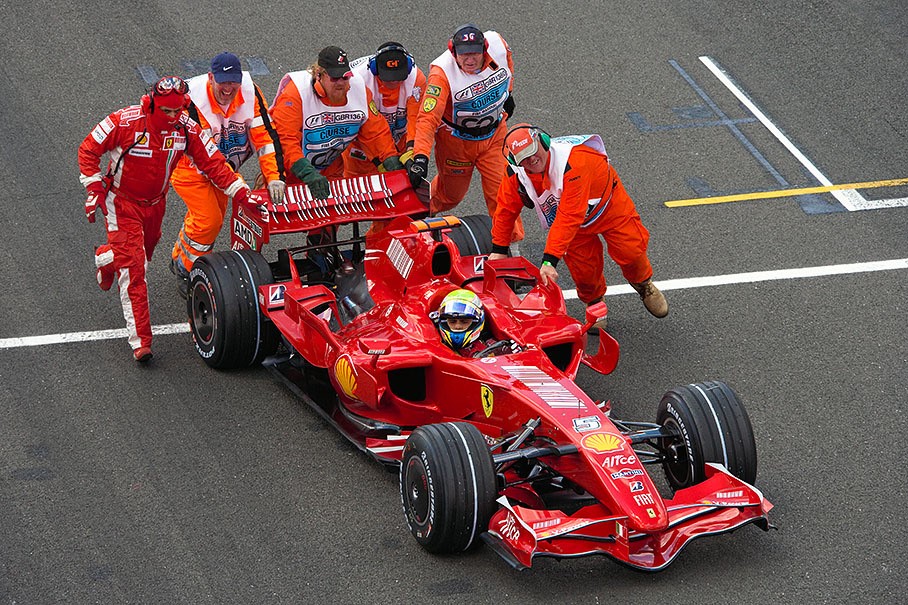
Felipe Massa being pushed to start from pitlane at Silverstone in September 2007. Photo by Rainer Schlegelmilch.
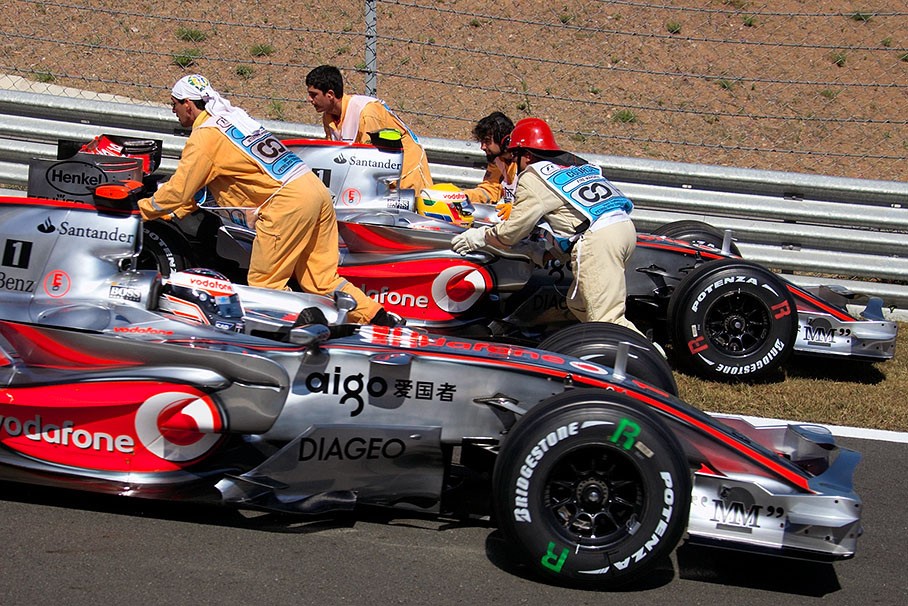
Whilst Hamilton's car is being pushed back by marshals, Alonso passes at pitlane exit at the 2007 Turkish Grand Prix in Istanbul. Photo by Rainer Schlegelmilch.
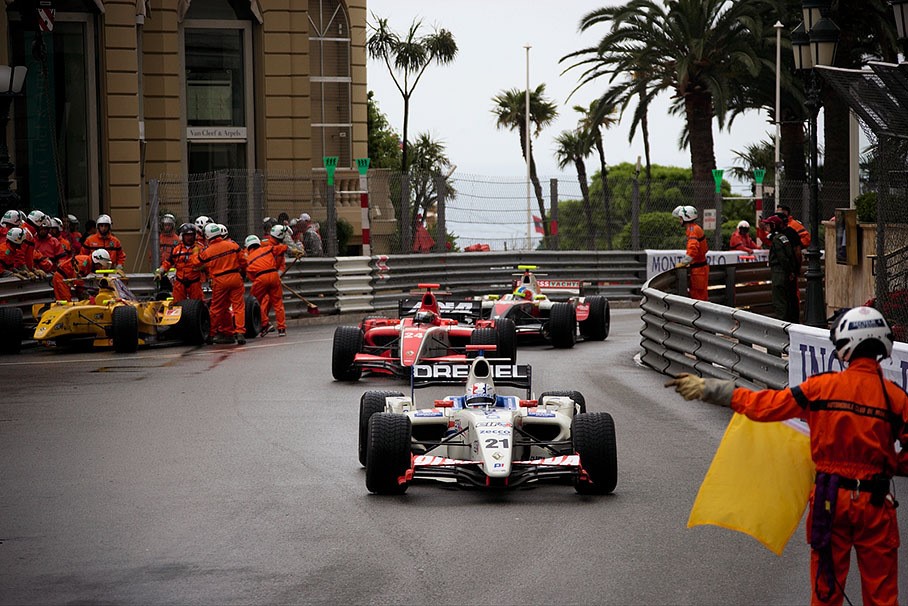
GP2 at Monaco in June 2008. Photo by Rainer Schlegelmilch.
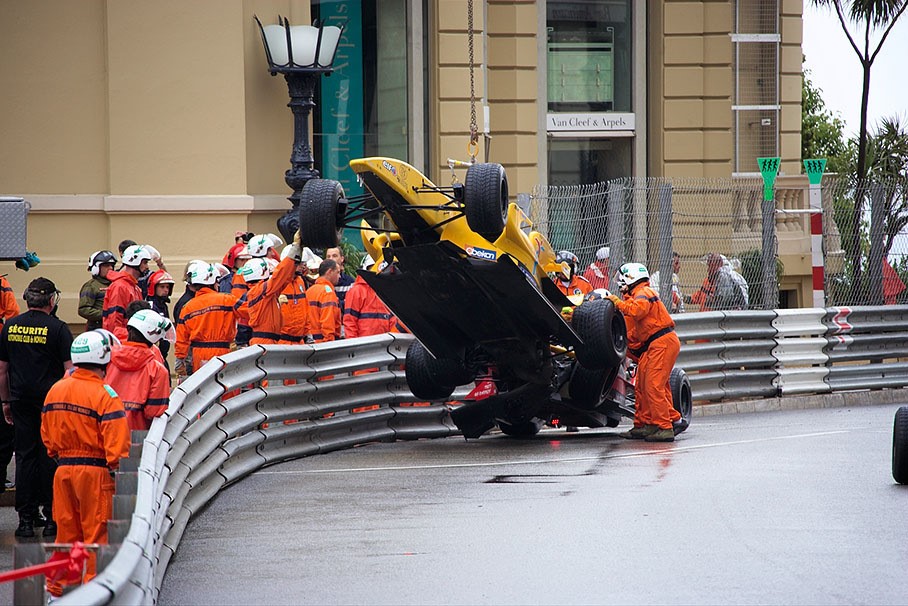
GP2 at Monaco in June 2008. Photo by Rainer Schlegelmilch.
One of the other benefits of marshalling is the ability to take part on a local level. Almost everyone will live close to a track or race meeting, whether it be a sprint course, off-road event or major circuit.
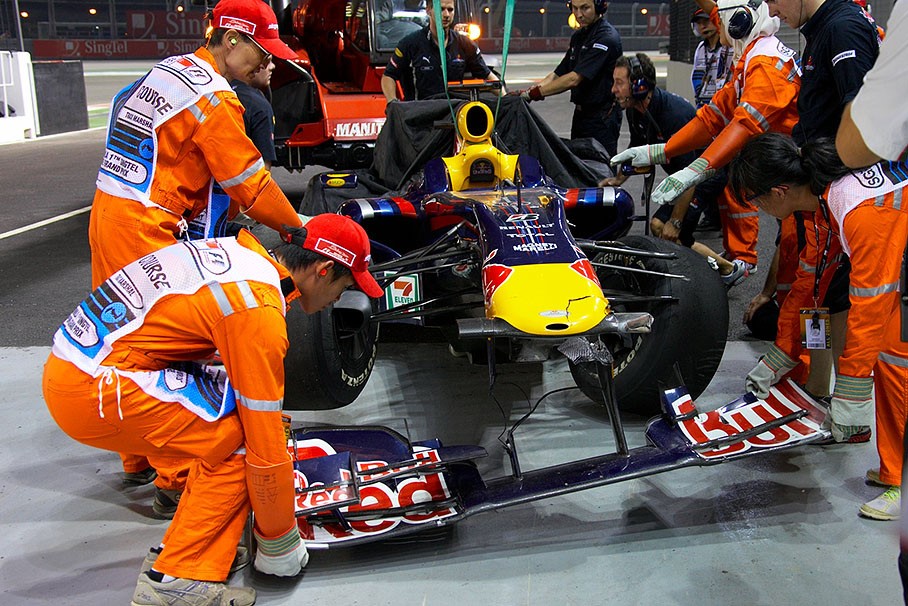
Webber's damaged car is carefully being brought back to pits after Friday's practice session, at the 2009 Singapore GP. Photo by Rainer Schlegelmilch.

Q1 is stopped, Fisichella's Ferrari is being removed, Sao Paulo, Interlagos, 2009. Photo by Rainer Schlegelmilch.
All levels and disciplines of motorsport require marshals. From motocross to hill climbs and rallying, marshals are responsible for more than just safety.
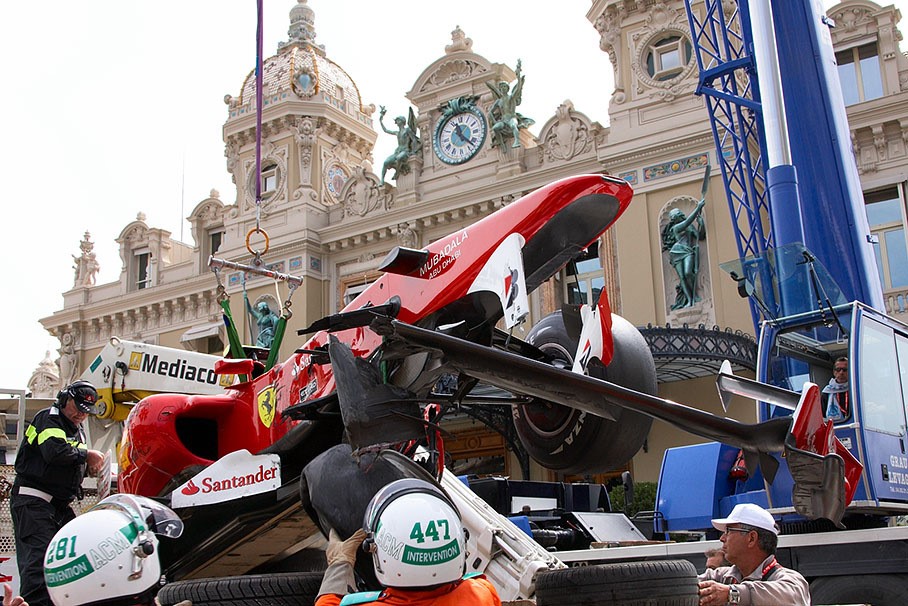
Alonso crashed his Ferrari car at Massenet turn during Saturday morning practice session at the Monaco GP in June 2010. Photo by Rainer Schlegelmilch.
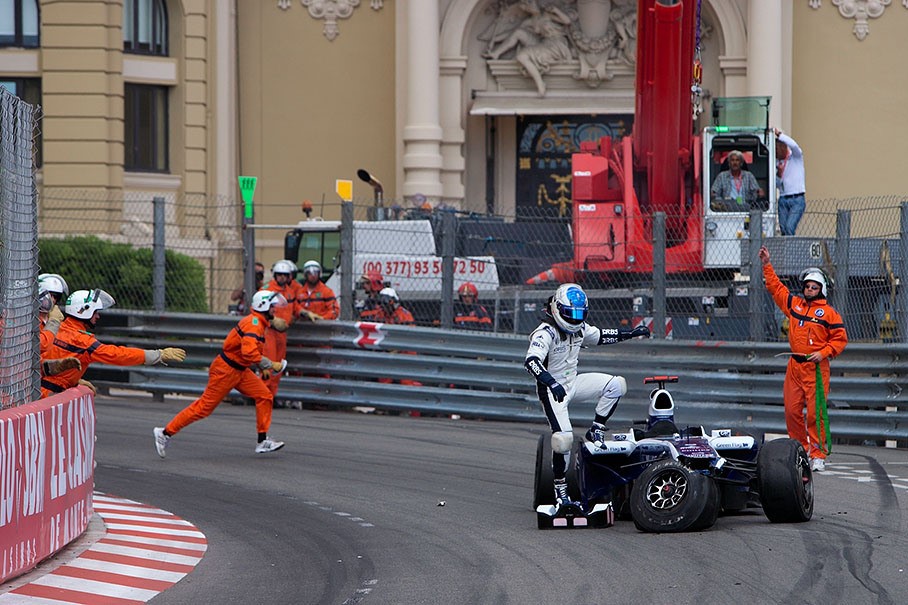
Rubens Barrichello exits the destroyed Williams car at Massenet turn at the Monaco GP in June 2010. Photo by Rainer Schlegelmilch.
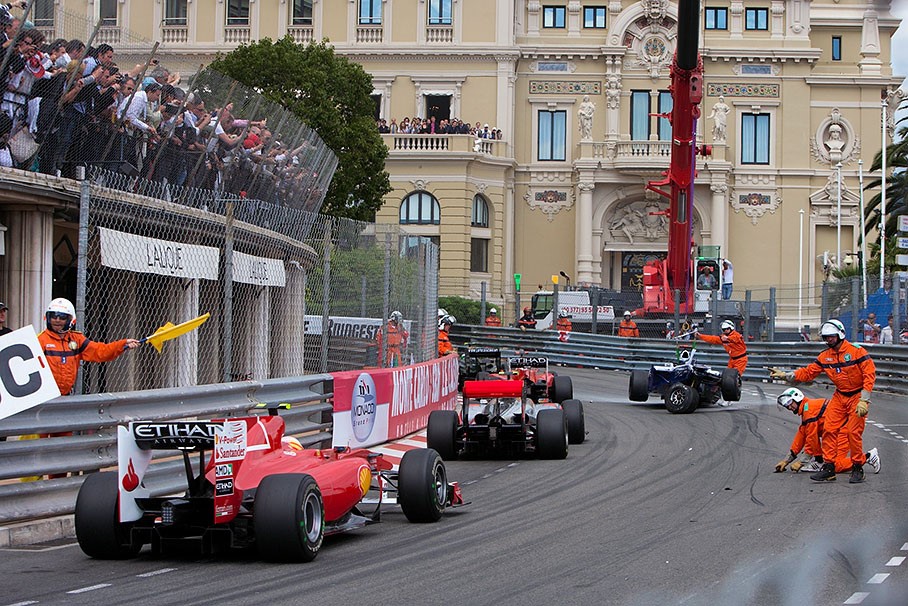
The field navigates around the remains of Rubens Barrichello's Williams car at Massenet turn at the Monaco GP in June 2010. Photo by Rainer Schlegelmilch.
This is where it gets interesting for those looking to forge a paid career in motorsport.
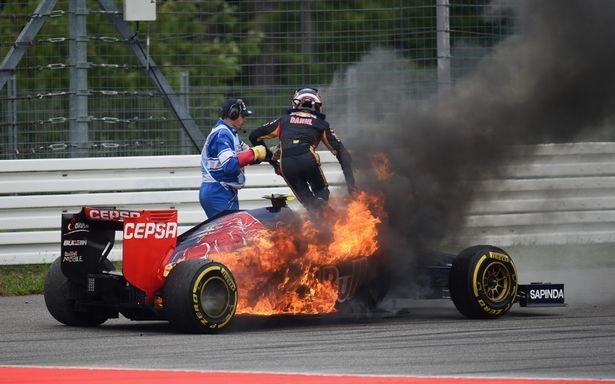
Daniil Kvyat of Russia and Scuderia Toro Rosso jumps out of his car after it caught fire during the German Grand Prix at Hockenheimring on July 20, 2014 in Hockenheim, Germany. Photo by Christopher Lee/Getty Images.
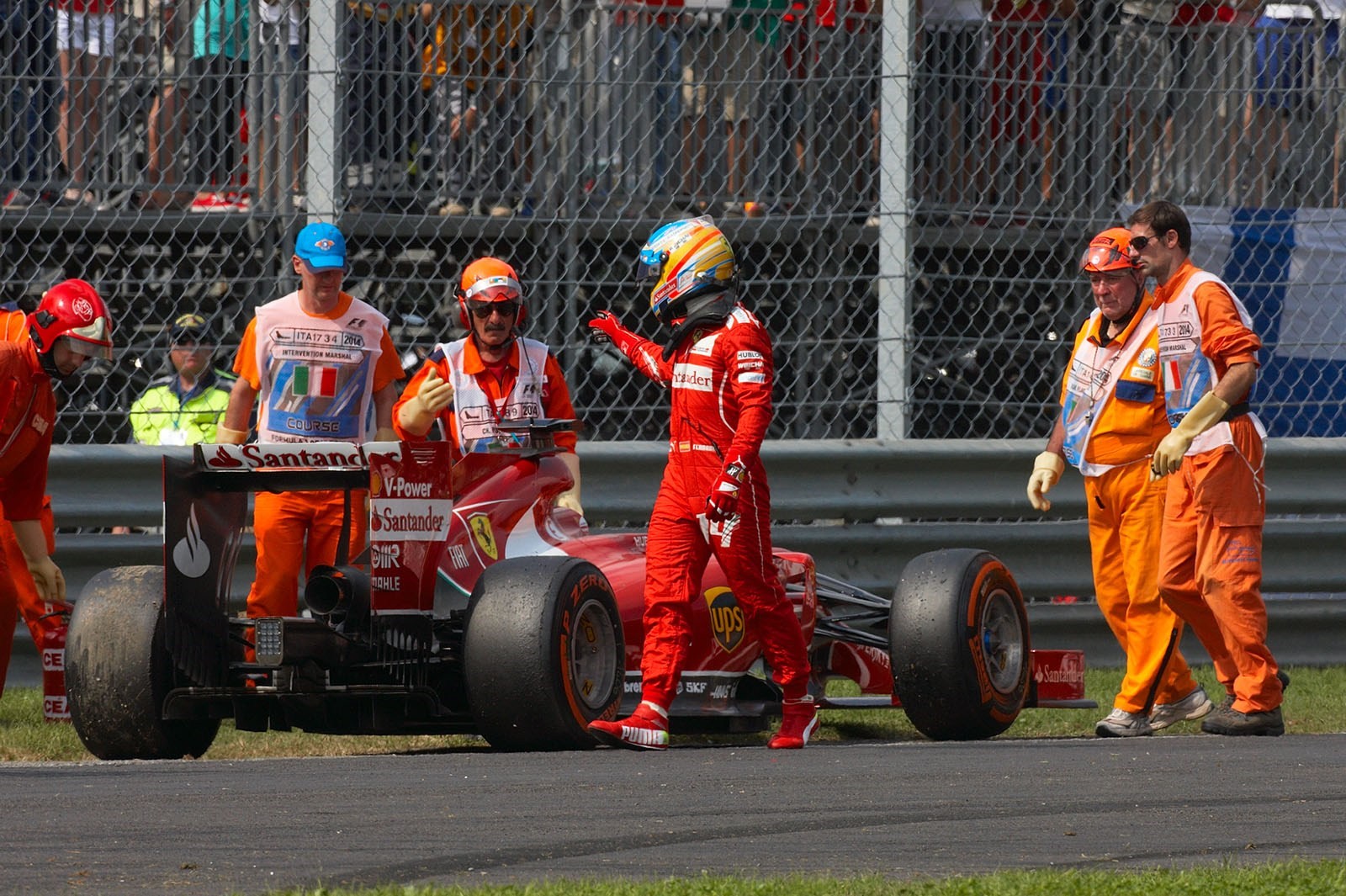
Fernando Alonso has to stop his Ferrari with a problem in the Energy Recovery Systems (ERS), Italian Grand Prix, Monza, 2014. Photo by Rainer Schlegelmilch.
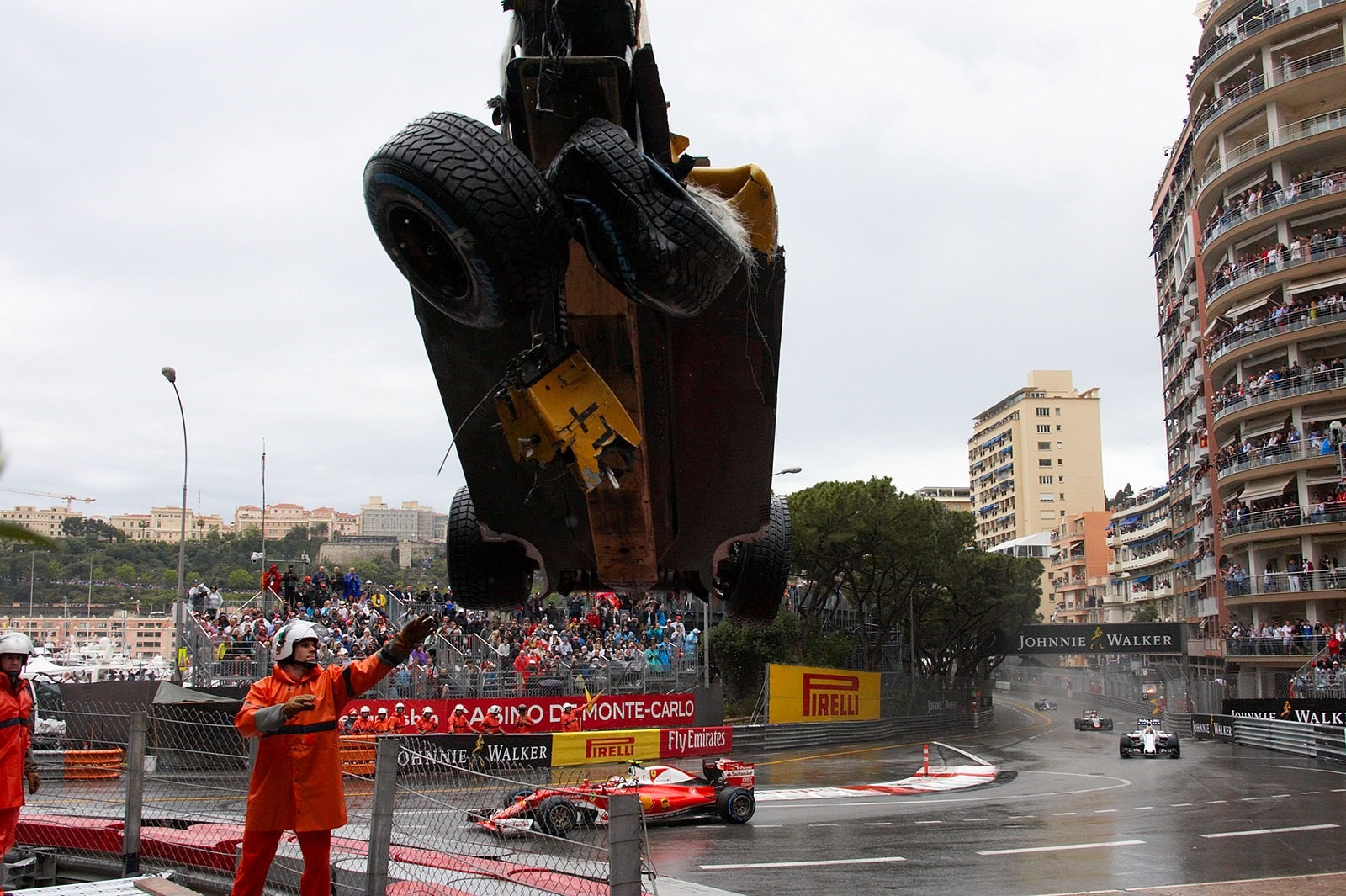
Race leader and still on heavy wets: Lewis Hamilton, Mercedes, Monte Carlo Grand Prix, 2016. Photo by Rainer Schlegelmilch.
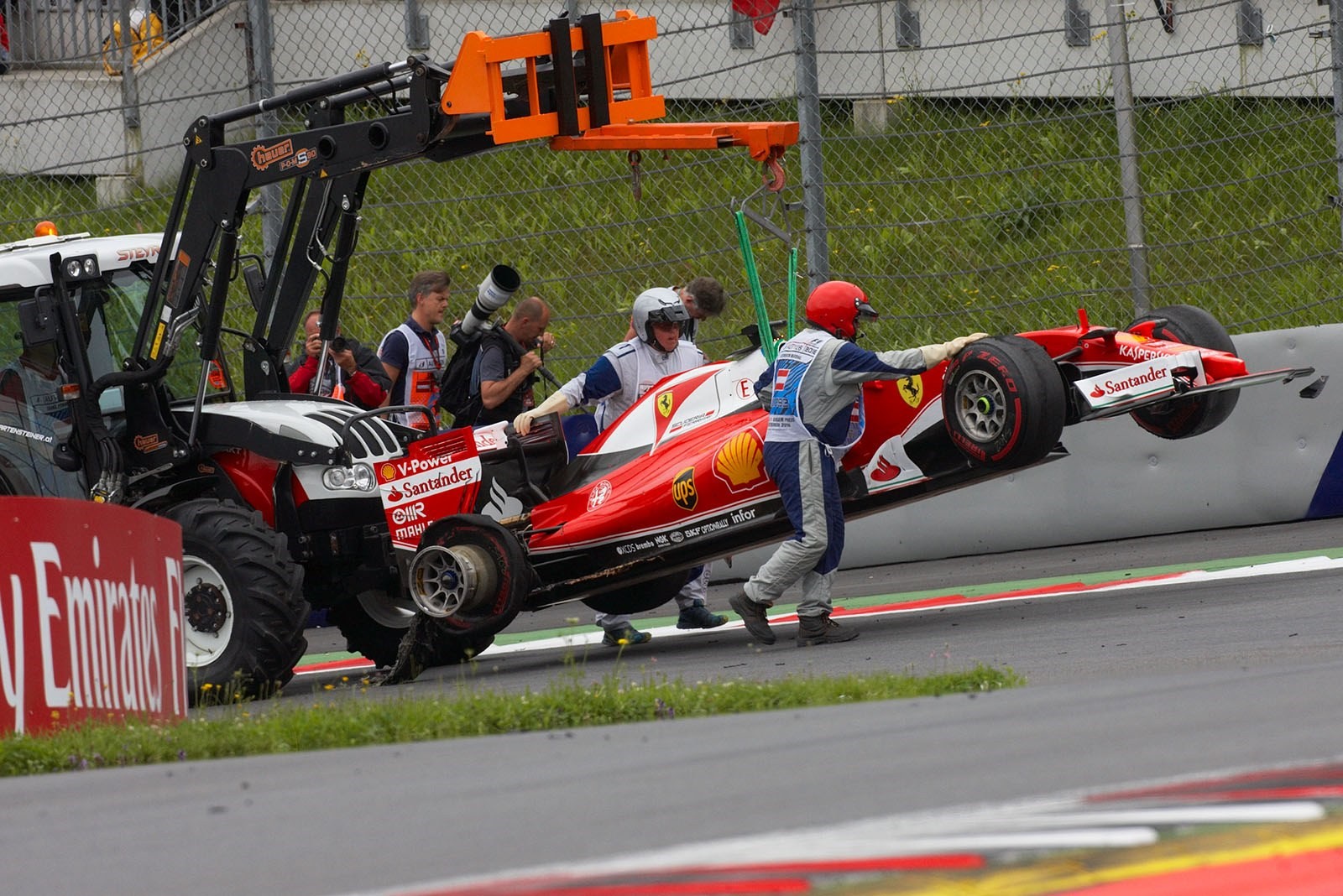
Sebastian Vettel, Ferrari, is out of the race on lap 27, Spielberg, Austrian Grand Prix, 2016. Photo by Rainer Schlegelmilch.

Vettel's Ferrari had a right rear tyre failure on the start/finish straight on lap 27 out of 71, Spielberg, Austrian GP, 2016. Photo by Rainer Schlegelmilch.
Other marshalling responsibilities include scrutineering, timing, pit and grid work and stewarding. Essentially, there is no other role where you get to witness so many facets of working in motorsport first hand.
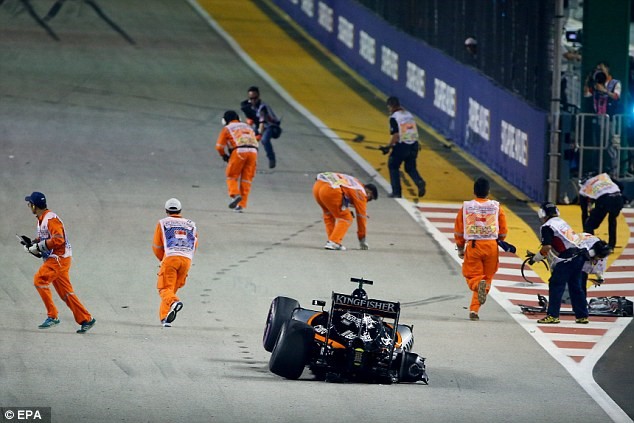
2016 Singapore GP. Marshalls recover debris from the crash under safety car conditions before the car is cleared.
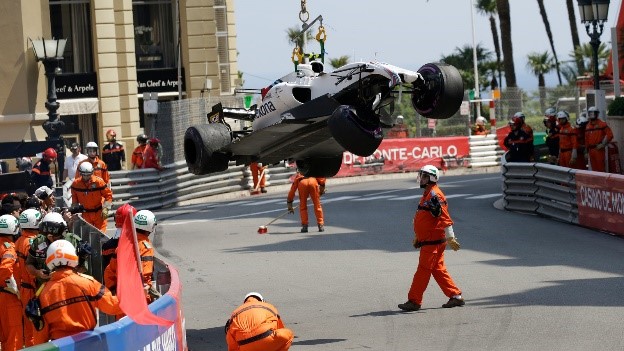
Marshals attend to the Williams driven by Lance Stroll after a crash in practice at Monaco in 2017. Race stewards help protect the marshals and other trackside workers. Credit: Claude Paris/Associated Press.
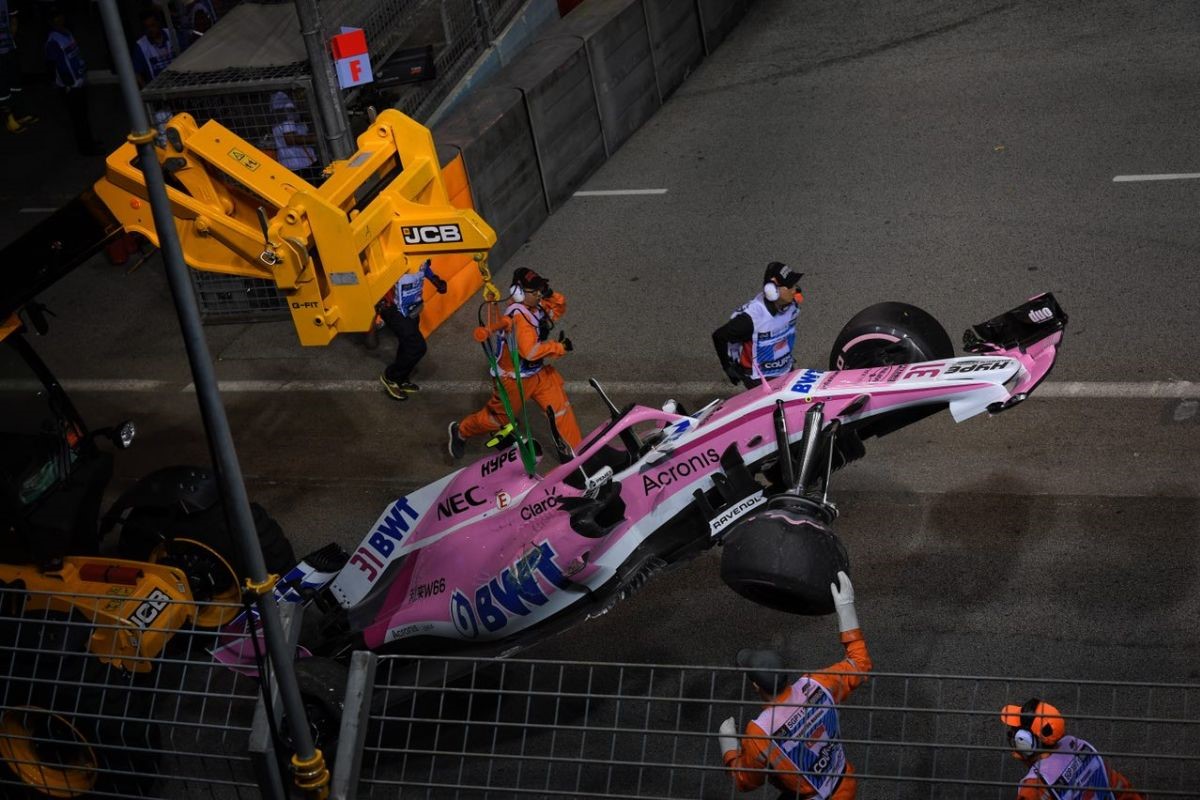
2018 Singapore Grand Prix. A crane lifts Esteban Ocon's damaged Force India from the track after he crashed with teammate Sergio Perez.
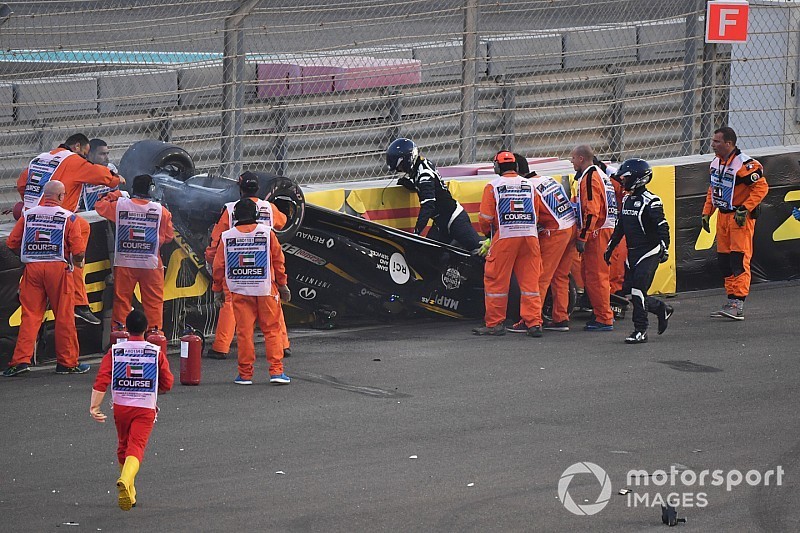
2018 Abu Dhabi Grand Prix. Hulkenberg's car came to rest upside down, leaning against the barrier at the outside of the Turn 8/9 chicane, after he was sent into a series of flips by his clash with Romain Grosjean.
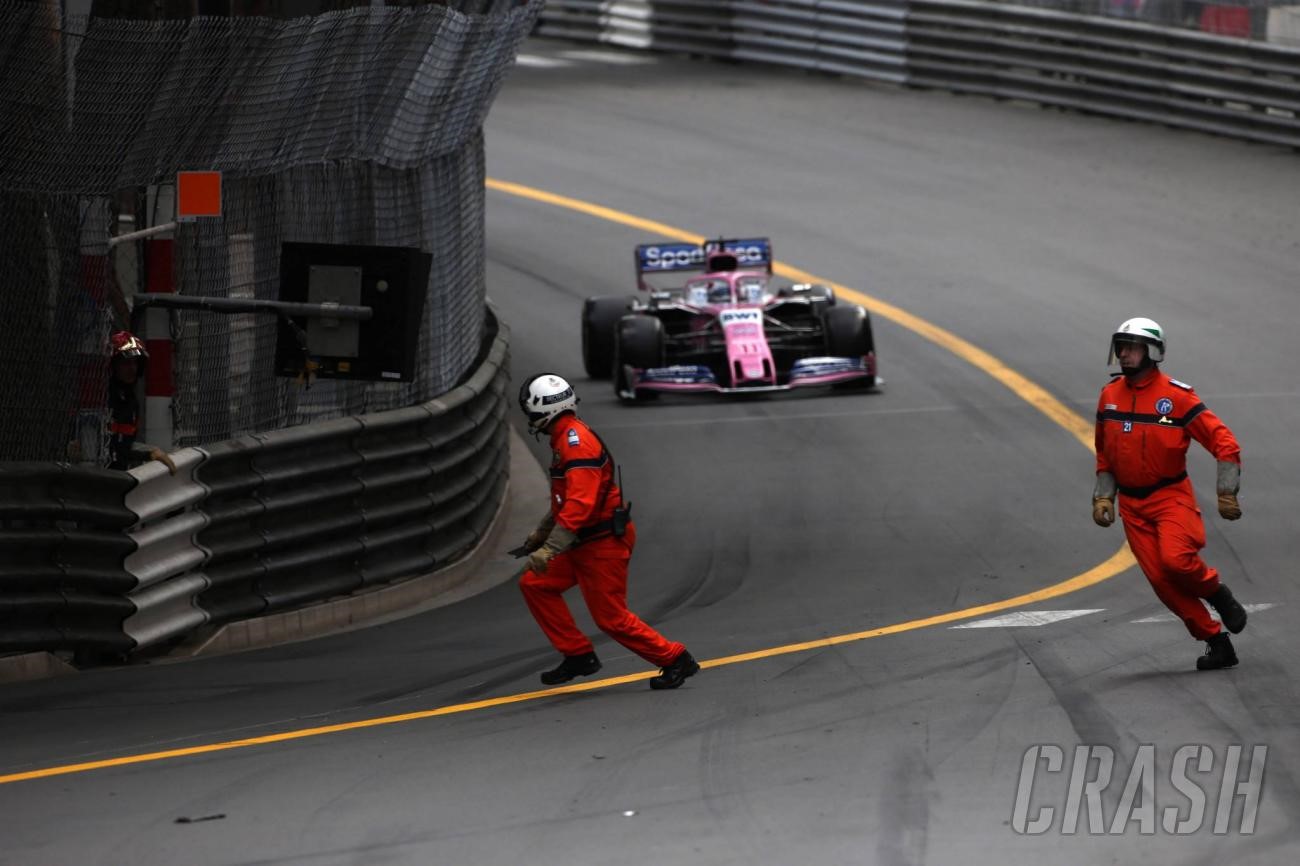
Sergio Perez came inches away from hitting a marshal at the 2019 Monaco Grand Prix during the Safety Car period.
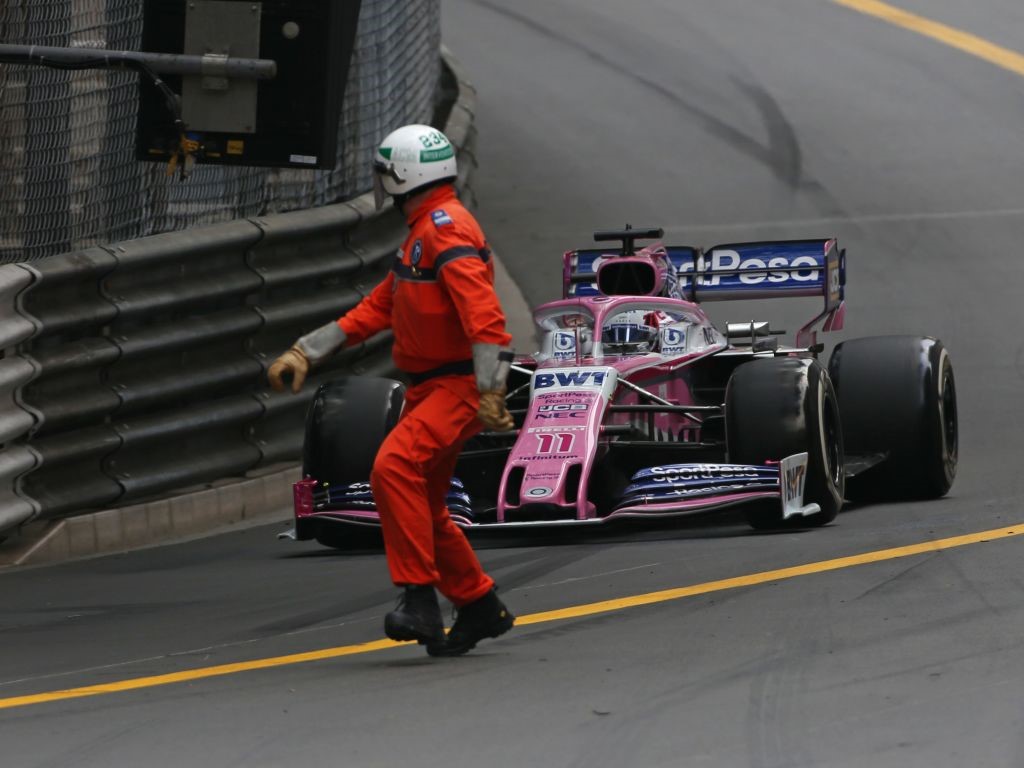
Sergio Perez was left shaken after he almost ran over two marshals under Safety Car conditions in the 2019 Monaco Grand Prix.
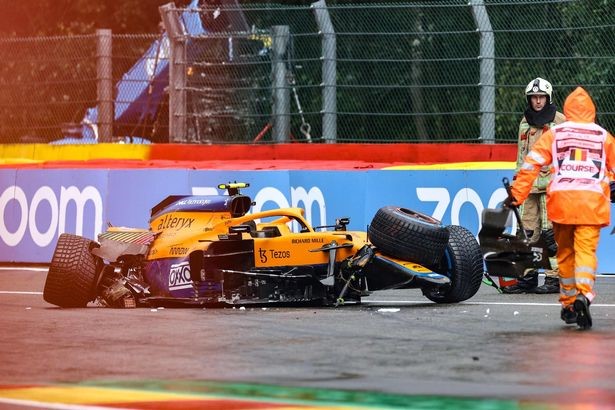
Lando Norris horror crash cancels 2021 qualifying for Belgian Grand Prix. Image: AFP via Getty Images.
This level of experience and dedication will only improve your chances of securing a job in this highly competitive industry.
Formula 1 marshals: who are they, what they do & do they get paid? By Stephen Lickorish. June 2, 2021.
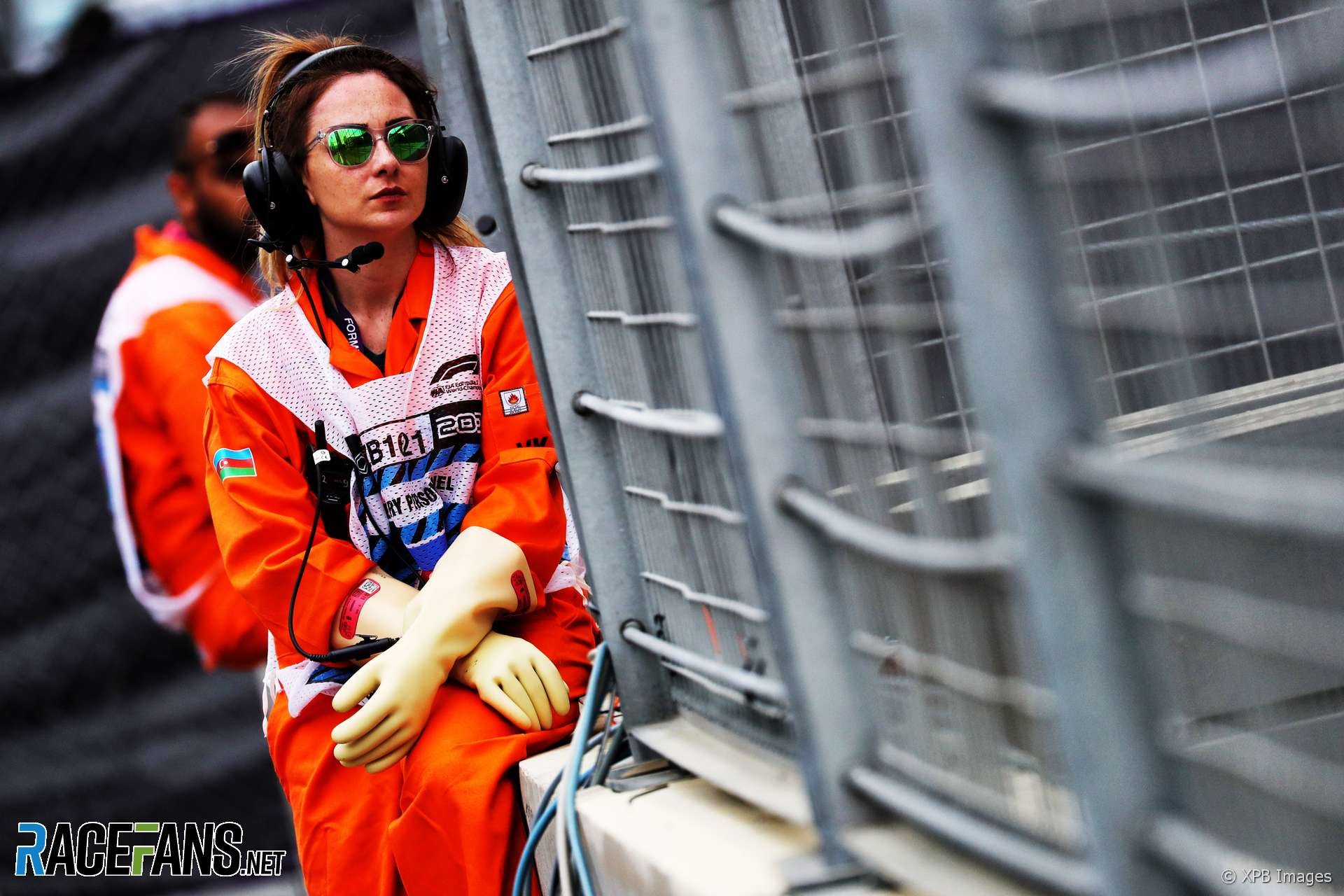
Marshal, Baku City Circuit, 2018.
The Azerbaijan Grand Prix is traditionally one of the busiest Formula 1 races for marshals, thanks to the punishing nature of the Baku street circuit.
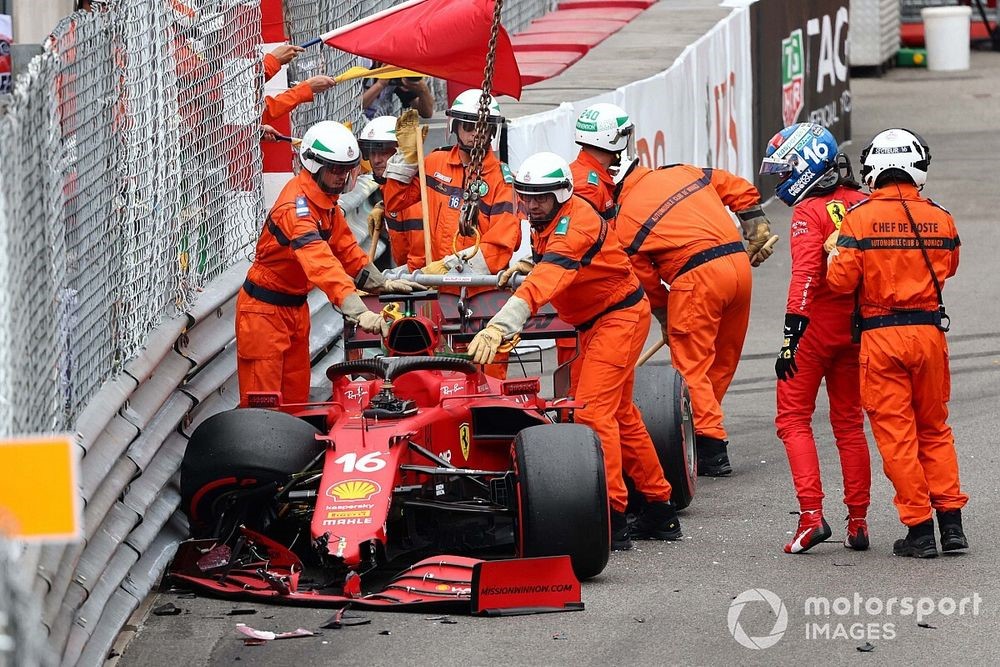
But marshals have a much wider remit than just clearing up damaged F1 cars.
They are essential in the successful operation of motorsport in the UK and beyond, performing important tasks while also getting up close to the action.
Here's a guide to what marshals are and how you can get involved, from a car racing perspective.
What is a marshal?
Marshals play a vital part in allowing motorsport events to take place. Dressed in their unmistakable orange overalls, these volunteers carry out a variety of roles, such as moving damaged cars off the race track, to enable motorsport events to take place successfully and safely.
Who can be a marshal?
Almost anyone can be a marshal. As long as you're physically fit enough to carry out the duties of a marshal, you can sign up and there's no upper age limit. Children can get involved too, those aged between 11 and 17 can become a marshal provided they are accompanied by an adult at all times. There are no other restrictions surrounding who can be a marshal.
How do you become a marshal?
The best way to get involved is by signing up to a marshals' club, such as the British Motorsports Marshals Club. These organisations will be able to provide you with full training to undertake different roles.
A great way to see if marshalling is for you is by taking part in a taster day. These are held at an event and allow you to observe and try out a range of duties marshals perform and gain a better understanding of what it involves.
What are the key roles and tasks of the marshals during a race weekend?
There is a huge variety of different roles and tasks that a marshal can carry out, ranging from the obvious duties that can be seen on TV to lesser-known administrative roles. Here are some of the key types of marshal.
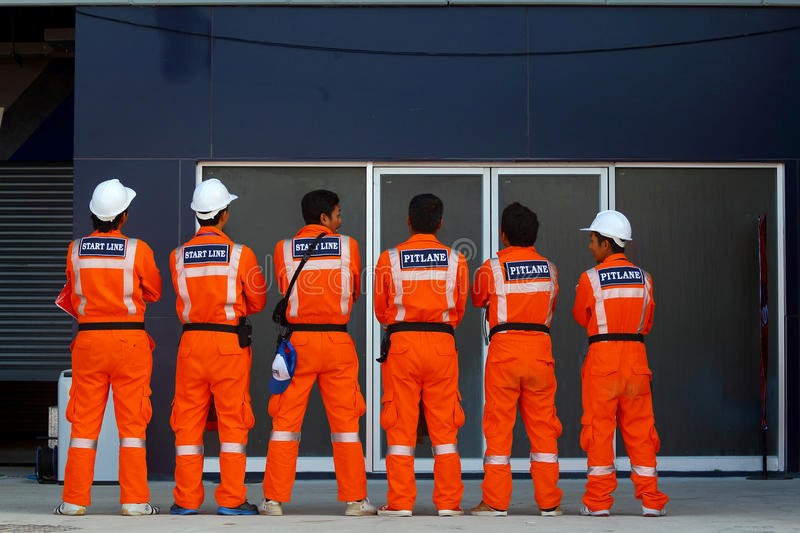
Marshals were prepared to work in the Super GT race car 2014 at Chang International Circuit, on October 4-5, 2014 at Buriram, Thailand.
Trackside marshals: these are the marshals that perhaps most obviously spring to mind and can regularly be found on our TV screens. It is their responsibility to help ensure that the track is clear of any potentially hazardous obstacles. This involves recovering damaged or broken down cars and moving them to a place of safety and can also include clearing debris, gravel or oil from the circuit.
Flag marshals: another of the more visible types of marshal is a flag marshal, who gives important signals to the drivers on track. This can include warning competitors of a potential hazard, like a spun car, by waving a yellow flag or letting racers know the track is clear again by showing a green flag. The finishline marshal has the additional task of waving the chequered flag at the end of the race.
Pit marshals: this group of marshals is based in the pitlane and they are called into action during the rare occasions when there is an incident in the pits. This could be a collision between cars entering and leaving their pitboxes or could be tackling a fire when refuelling. Some pit marshals are also equipped with a speed gun to make sure drivers are not exceeding the permitted speed when travelling down the pitlane.
Startline marshals: these marshals play a significant part before the start of the race, making sure that cars are all correctly lined up on the grid. They then wave a yellow flag if any driver stalls or struggles to get off the line when the race begins.
Paddock marshals: marshals aren't just needed directly around the circuit itself, they can also undertake other roles at the venue. Paddock marshals carry out a variety of tasks including making sure cars are all correctly lined up in the assembly area, before they head out to the grid.
Administrative marshals: Marshals also carry out a number of behind-the-scenes administrative duties, such as communicating between the marshal post chiefs and the clerk of the course, who is in charge of the race. Just because this group of marshals is less visible, it doesn't mean they don't have an important role to play in ensuring race meetings run successfully.
It is not just circuit racing events where marshals are required - they are also vital in a number of other disciplines including rallying, karting and hillclimbs.
Do marshals get paid?
Marshals are volunteers and don't get paid, per se. Given marshals are required to work in all weathers and conditions, this is why it is vital that they are passionate about motorsport.
Some organising race clubs offer vouchers, tokens, food or small sums of money to marshals and this varies between different promoters. They may also organise competitions and raffles for prizes like on-track driving experience days.
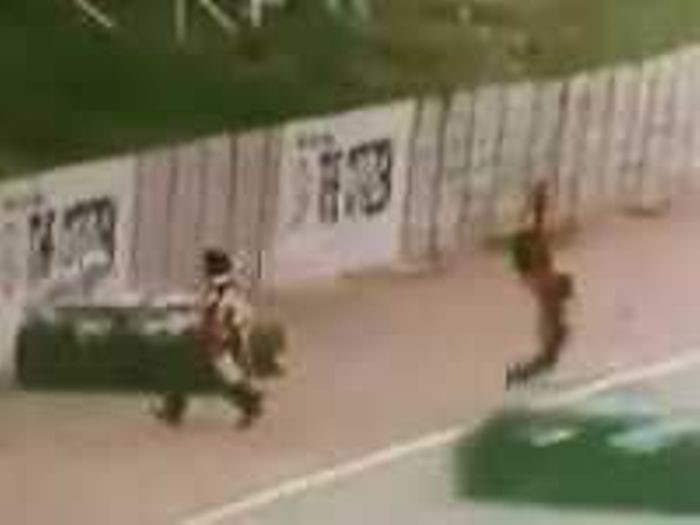
Screenshot from the exact moment Tom Pryce hit and split a marshal in two at Kyalami, South Africa, in 1977.
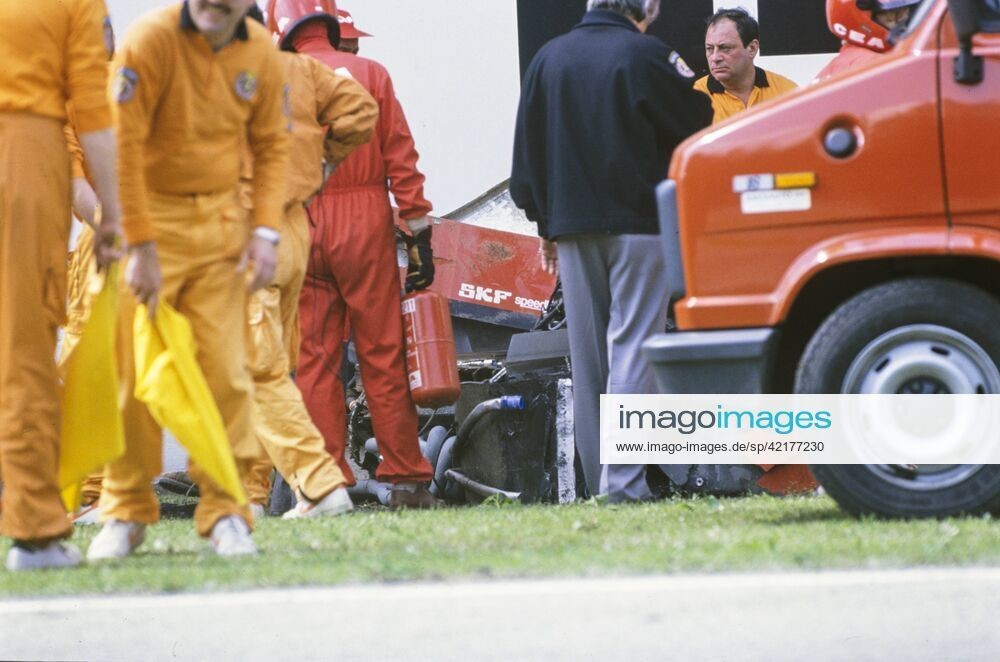
Marshals attend Gerhard Berger s Ferrari 640 after an accident during the San Marino GP at Imola, Italy, on April 23, 1989.
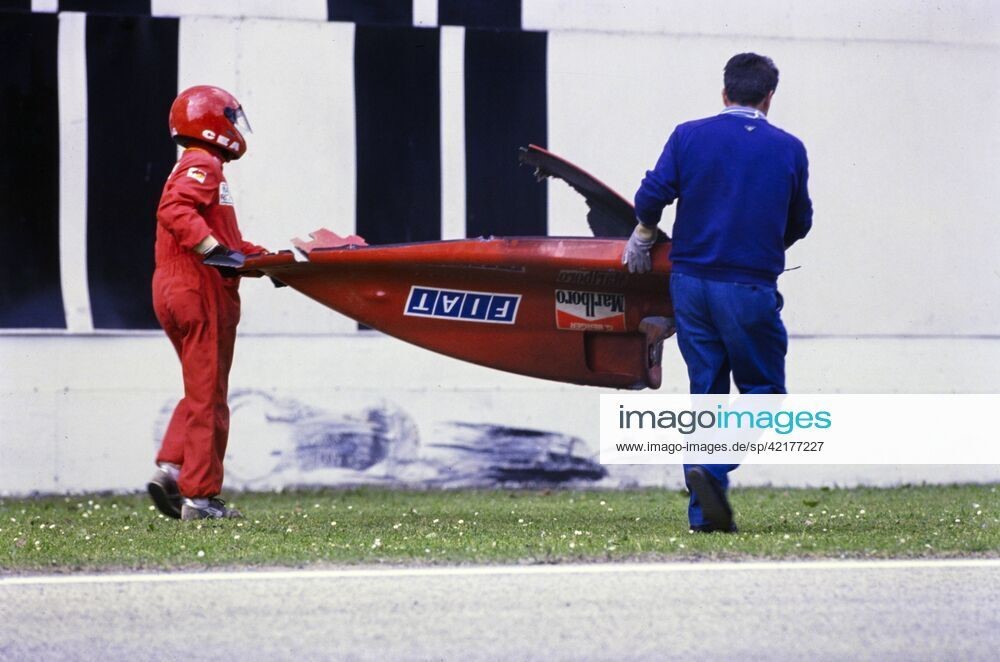
Marshals carry away the rear bodywork of Gerhard Berger s Ferrari 640 after a crash during the San Marino GP at Imola, Italy, on April 23, 1989.
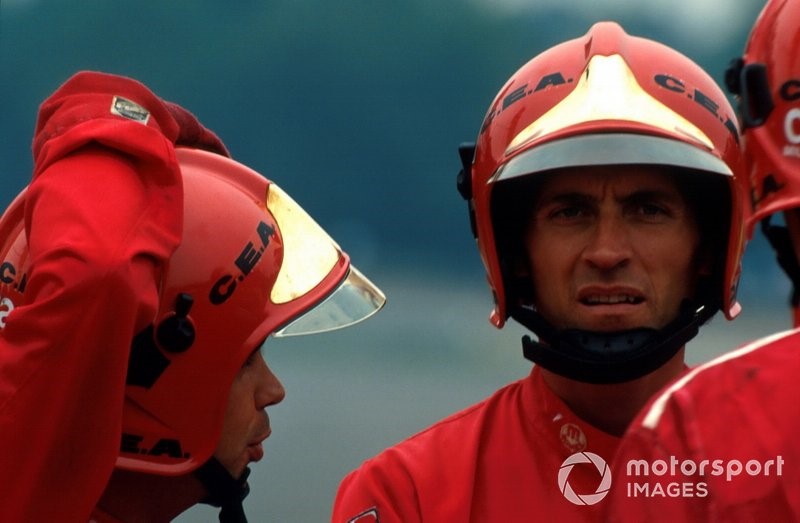
The fire marshals were to save the life of Gerhard Berger, Ferrari. Photo taken by Sutton Images on April 23, 1989.
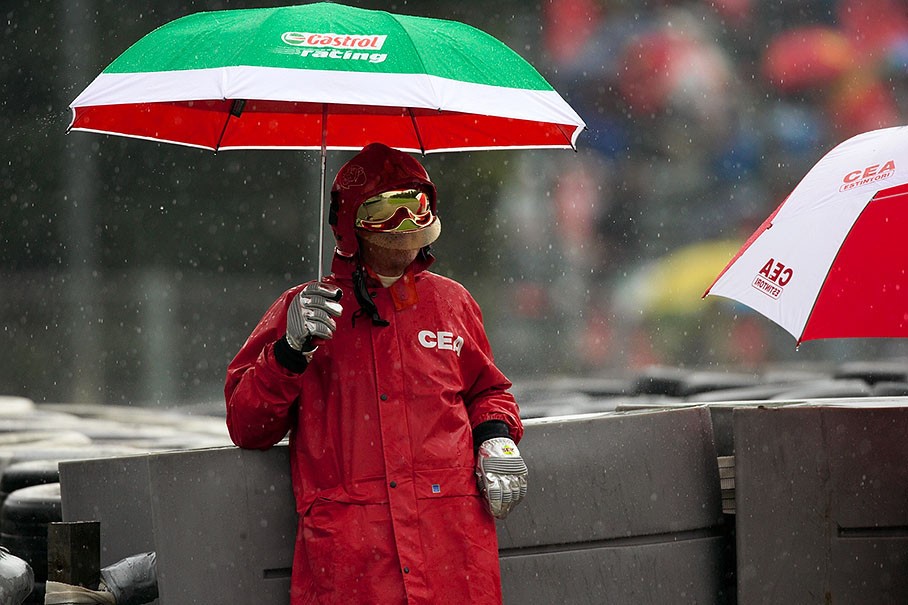
A fire marshal under his umbrella during a rain-suspended session at Monza in 2008. Photo by Rainer Schlegelmilch.
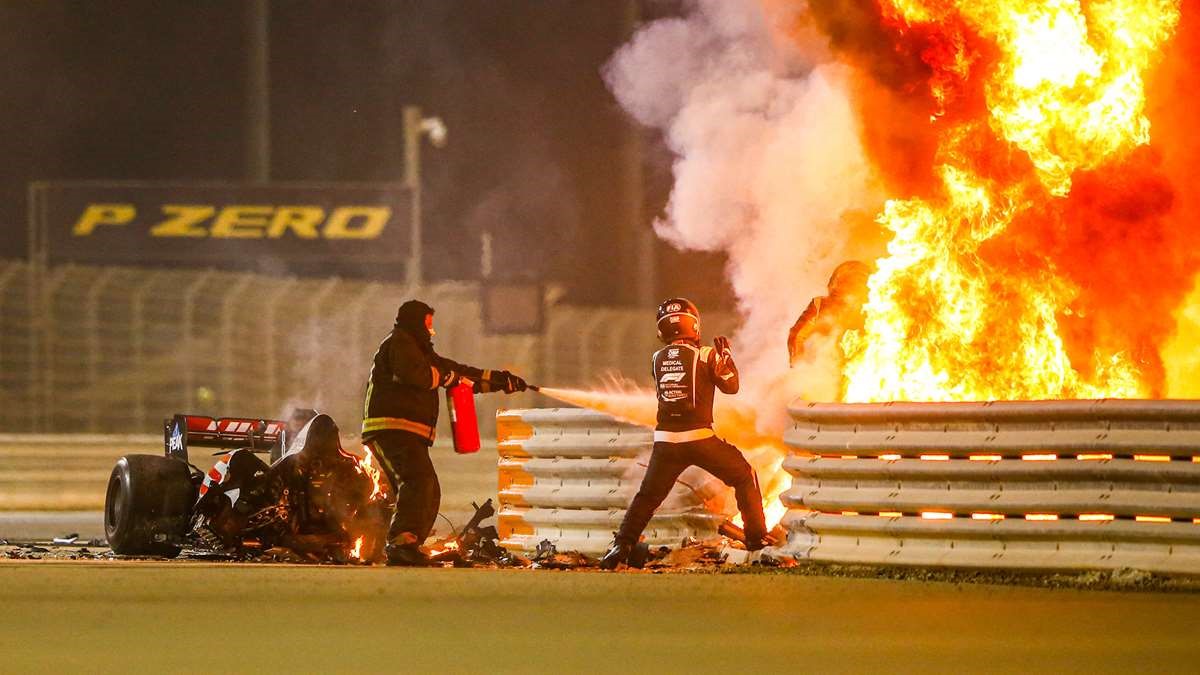
Romain Grosjean’s horrifying fireball crash on the first lap of the 2020 Bahrain Grand Prix.
Why are marshals essential to all motorsport activity?
Without marshals, there would quite simply be no motorsport. The wide-ranging nature of the roles that are performed by marshals make them vital to the successful running of motorsport events and for ensuring that all competitors are safe.
How do you become an F1 marshal?
Just like drivers, there are different grades of marshal, which depend on experience and dictate the roles a marshal can complete. For those wishing to work at a Formula 1 event, they must be a minimum of 18 years of age and have been a marshal for at least a year. There is also a stipulation that a marshal must have performed the role they're applying to carry out for a set number of days in the previous year. Applications are then submitted by clubs and a selection process is conducted - not everyone who applies will be granted a place.
UK marshals do not just have to apply to the British Grand Prix, they can apply to a variety of overseas events - including the Le Mans 24 Hours and F1 races around the world.
Remembering James Hunt's infamous Mosport punch. Formula One racing in the 1970s was dangerous; and not just for the drivers. By Brendan McAleer. September 2, 2013.
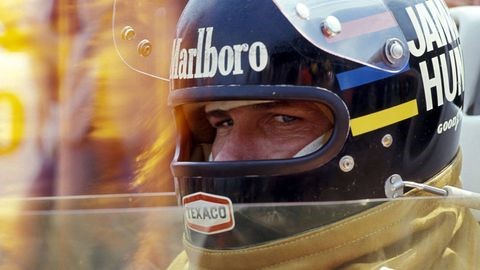
James Hunt at the Canadian GP in 1977.
Ron Howard's Rush had its world premiere over the weekend in London. That means that James Hunt is about to become known to a group of people that extends well beyond ardent racing fans. This revisits our June story about Hunt's 1977 trackside run-in with a volunteer race marshal at Mosport.
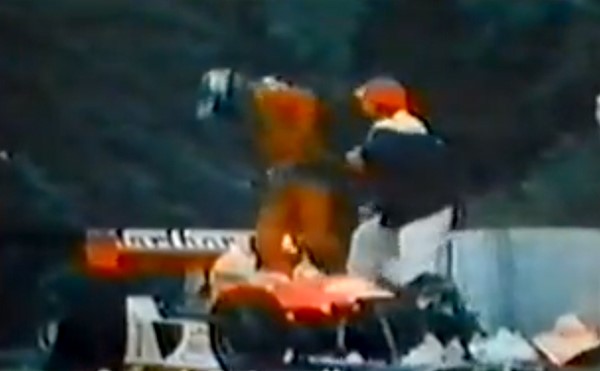
The scene is Mosport. James Hunt exits his wrecked car and stumbles back toward the racetrack, wearing only one shoe.
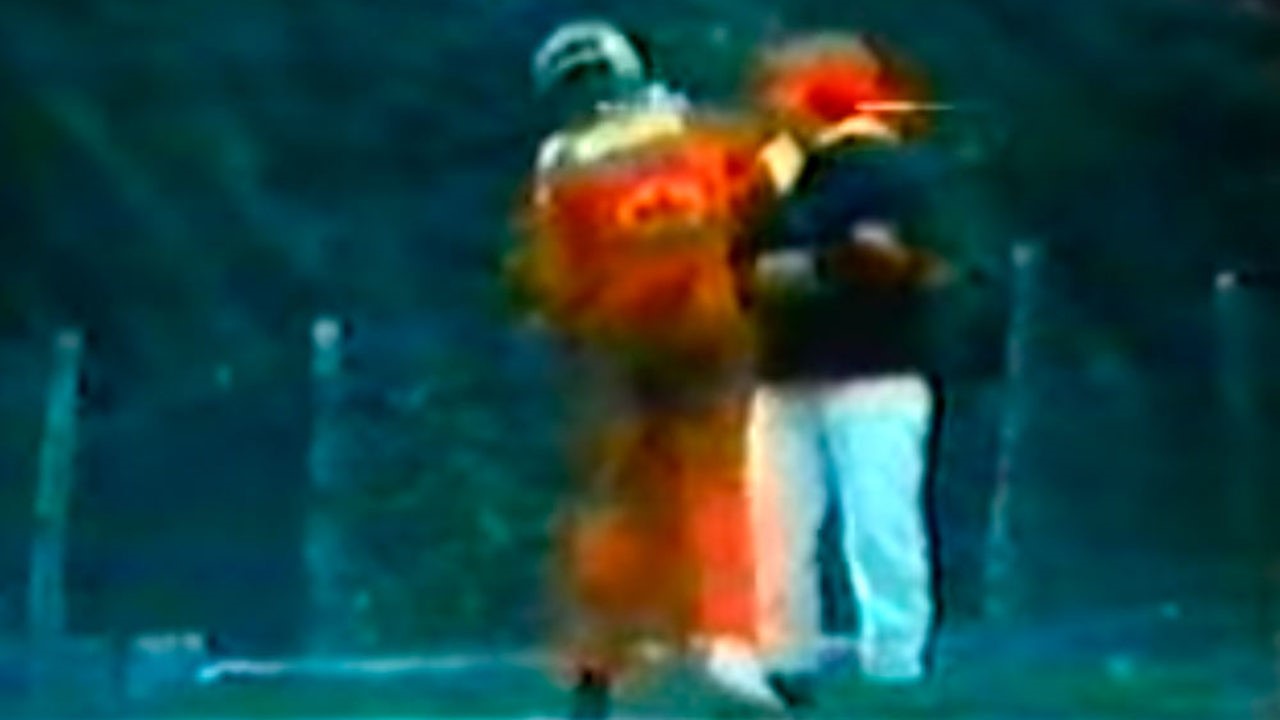
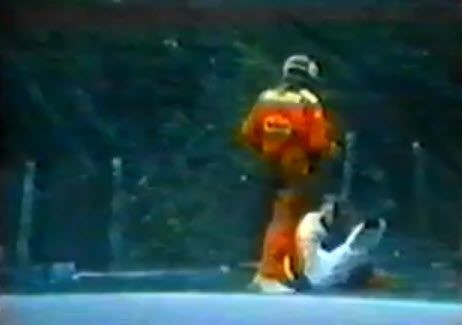
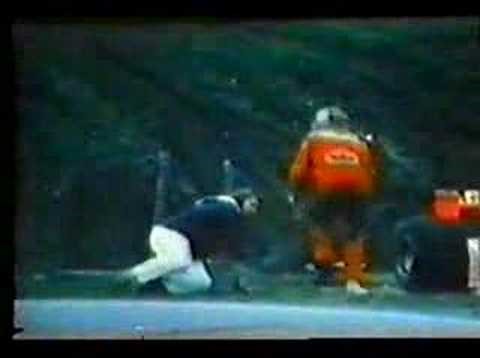
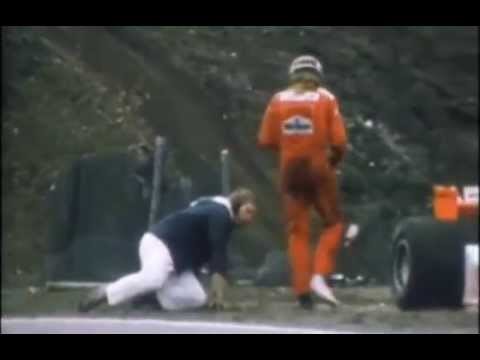
A red-capped race marshal grabs his shoulder to pull the Brit to safety and pow! Hunt socks him in the mouth.
It was a typically puzzling moment from one of motor racing's most quixotic personalities. While Hunt's randomly thrown haymaker may have amused some TV viewers, being on the receiving end of it can't have been any fun. So who was the man he punched?
This content is imported from YouTube. You may be able to find the same content in another format, or you may be able to find more information at their web site.
His name is Ernie Strong and, all these years later, he's still confused and upset about Hunt's behavior.
"How did I feel?" Strong says, "wronged, blindsided — did that really happen?"
Hunt punched hard, too. Another corner worker noticed blood trickling out of Strong's jaw afterward, so he rode to Race Med in an ambulance to get checked out.
What happened to put Hunt off the track and then his fist into Strong's face?
Coming off a win at Watkins Glen, Hunt was closing out a disappointing follow-up his 1976 championship run. Niki Lauda had already clinched the '77 driver's title and elected to sit out the season's final two final races of the season. The Canadian GP would be a battle between the McLarens of Hunt and his teammate Jochen Mass and the Lotus team captained by Mario Andretti.
The race boiled down to a duel of giants: Andretti and Hunt left the rest of the field in the dust, lapping everyone but Jochen Mass. Bunching up behind the slower McLaren, Hunt managed to slip past Andretti's Lotus as the American put two wheels on the grass, but Mass was still in the way.
A miscommunication at speed between the two teammates ensued. Hunt explained at the time: "I was right up his chuff — I was forced to go left, then he suddenly moved across to the left, hit the brakes and waved me through on the right. But I was committed and couldn't avoid him. I hit him right up the arse."
Mass pitted for repairs and eventually finished third, but Hunt's McLaren was too badly damaged to return.
A few beats after the sucker punch, you'll see Hunt turn back toward the marshal in a sudden, somewhat contrite realization. Both men retreat to the safety of the barrier where Hunt removes his helmet, pushes his long blond hair back and gives the still-dazed Ernie Strong an apologetic half-hug of sorts.
Ernie says, "if I said anything to him, I can't remember. Hunt gave me a, 'sorry, old man' and headed back to the pits..."
The media had a field day, with headline writers working up their best/worst puns. Hunt was fined $2,000 — the maximum at the time — and Strong later successfully sued him in a British court. Far from taking the attitude that this was the sort of thing you expected from a mercurial wildman like Hunt, the unfairness of the thing still rankles the marshal. Strong was a volunteer and become some frustrated racer's punching bag is the sort of thing that's hard to forgive, particularly as Hunt never spoke to him beyond that one simple, "sorry, old man." After all, Strong was trying to get Hunt out of harm's way.
This month, we'll see Hollywood's version of the famous Hunt and Lauda battle at speed, and both men will be uplifted as heroes, just as modern F1 drivers are neatly packaged for the press.
The punch at Mosport is a reminder that the man who made a reputation as the life of the 1970s F1 party had his share of ugly moments, too.
Just ask Ernie Strong.
Joann Villeneuve and Eppie Wietzes named Grand Marshals for VARAC Vintage Grand Prix at CTMP. By Dave Drimmie. June 14, 2017 in Breaking News.
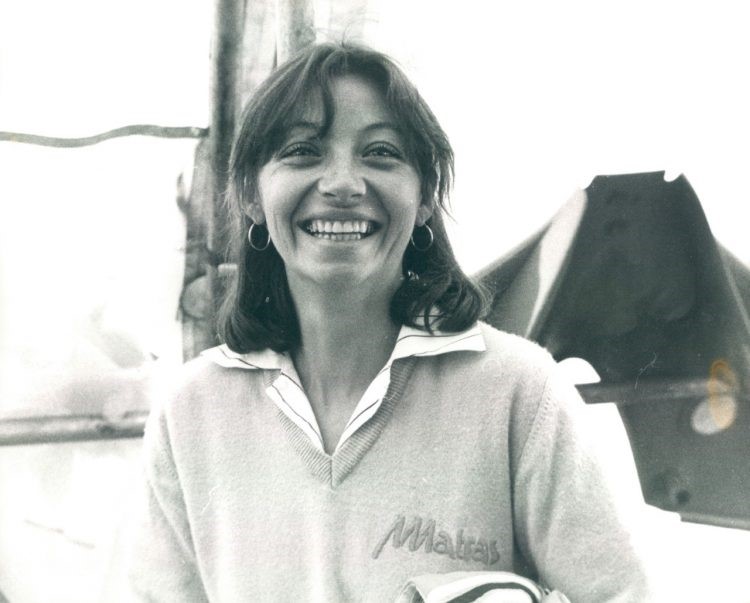
Bowmanville, on June 14, 2017 Joann Villeneuve and Eppie Wietzes have been named as the Grand Marshals for the Vintage Automobile Racing Association of Canada (VARAC) Vintage Grand Prix at Canadian Tire Motorsport Park this weekend, June 16-18. The weekend features the FIA Masters Historic Formula 1, celebrating the 50th anniversary year of the first F1 Grand Prix of Canada held at CTMP – then Mosport Park – on August 27, 1967.
Beautifully restored cars from the past 50-plus years of motorsports will take to CTMP’s world-famous Grand Prix circuit. Other feature events include the Canadian round of the 2017 Diamond Jubilee Formula Junior World Tour. This tour encompasses races in Europe, Australia, New Zealand and South Africa, at famous tracks like CTMP, Monza, Brands Hatch and Zandvoort.
Joann Villeneuve, wife of the late great former Formula 1 driver Gilles Villeneuve and the mother of Jacques – the only Canadian driver to have won the Formula 1 drivers’ championship (1997) – and Eppie Wietzes, who drove in two Canadian Formula 1 Grand Prix, will be on hand Saturday for the 50 Years of F1 in Canada Celebration meet and greet from 10:45 to 11:30 am. Fans will receive a vintage poster. Wietzes will then give the ‘start your engines’ command for the 1:30 pm start of the Masters race, while Villeneuve will wave the green flag from the starters stand.
“It’s an honour to do this,” said Wietzes. “I can’t believe it’s been 50 years already. I was 29-years-old when I drove that Lotus – lots of memories, the kind you never forget.”
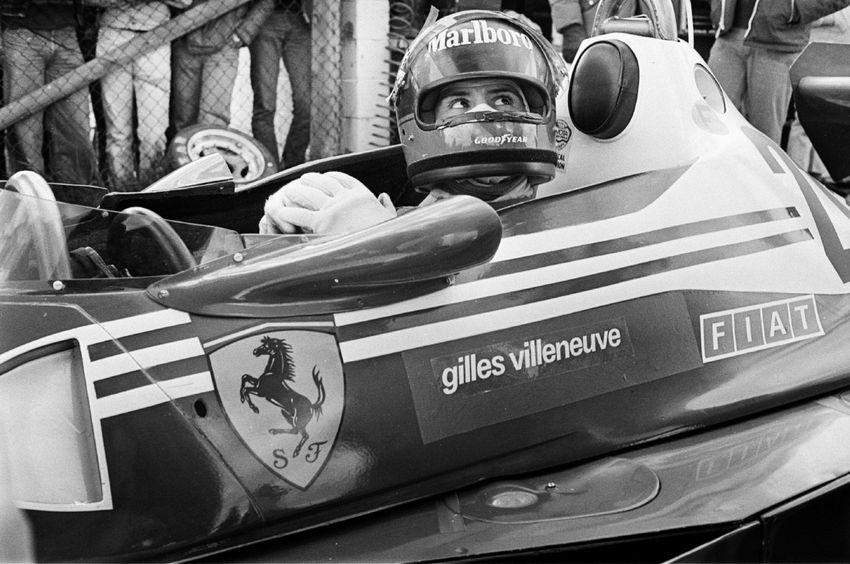
“It will be a trip down memory lane for me,” said Villeneuve. “There’s so many memories of being at Mosport and camping out with the kids on a race weekend – we had a blast. We loved that life.”
“It’s going to be a great Father’s Day weekend here at the track and what better way to spend it than with a unique trip down motorsports memory lane,” said Myles Brandt, President and General Manager, Canadian Tire Motorsport Park. “We are honoured to have both Joann and Eppie as our Grand Marshals for the weekend.”
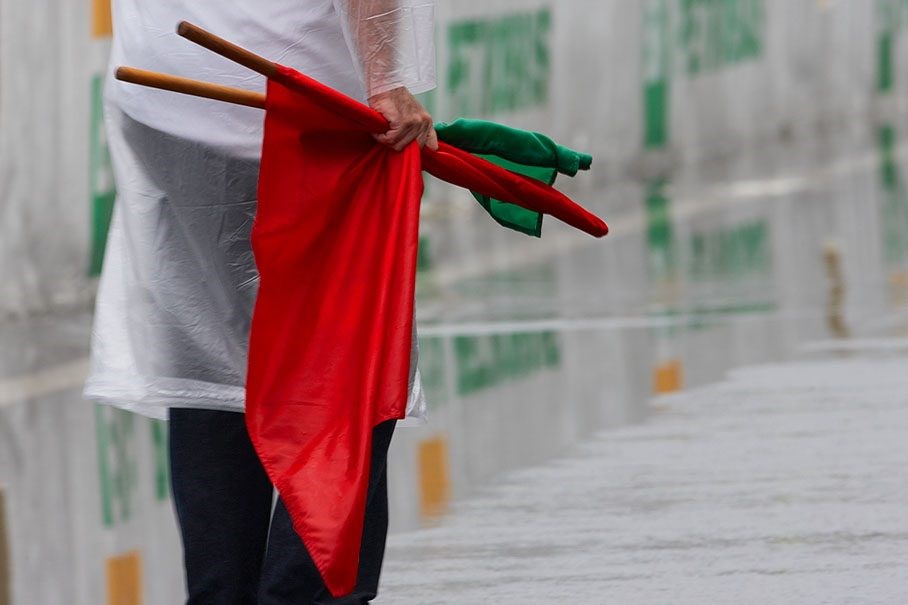
Optional signaling flags. Brazil, Sao Paulo, Interlagos, 2009. Photo by Rainer Schlegelmilch.
Contromano. F1. Race marshals, once upon a time with flags and today instead ... 24 November 2021. By Rodolfo Intelisano.

Felipe Massa, Ferrari at Monaco in May 2007. Photo by Rainer Schlegelmilch.
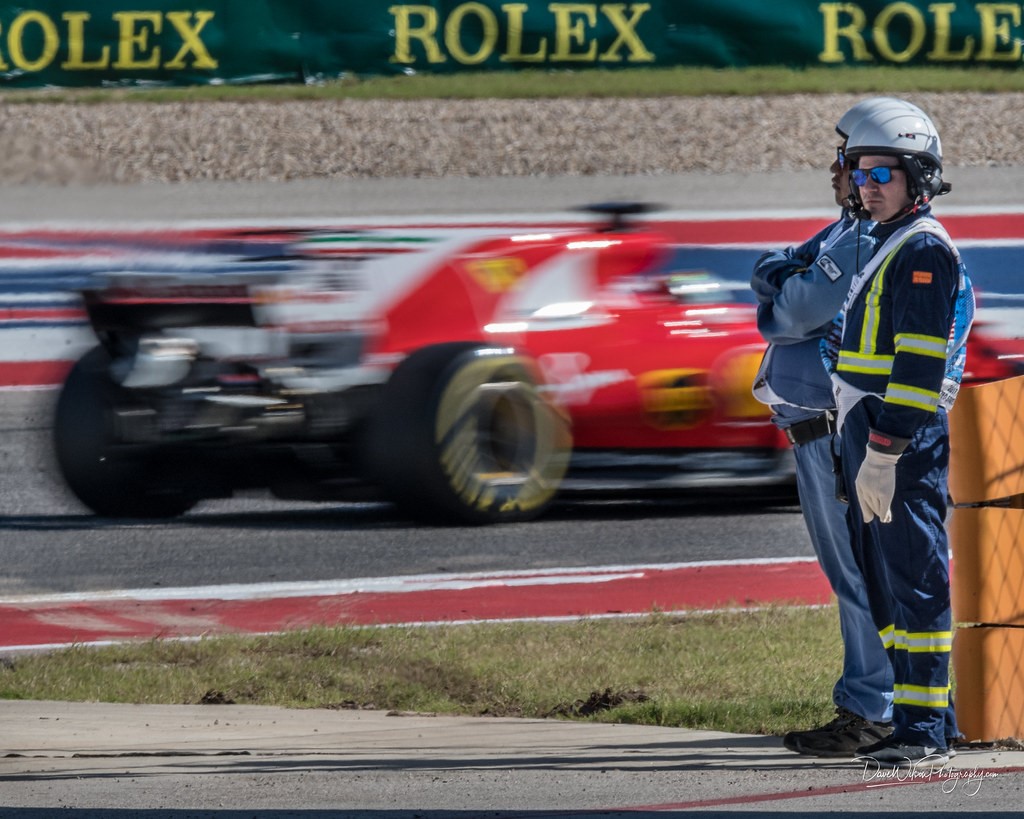
Race marshals at Circuit of the Americas are passed by Sebastian Vettel of Ferrari during the 2017 United States Grand Prix. Photo by Dave Wilson.
Once upon a time there were marshals and flags. The marshals were, like today, passionate volunteers but they were also generous and courageous people, you saw them move the cars, clean the track, spread the filler on the oil or empty the fire extinguishers while the racing cars passed a few meters from them.

Jackie Stewart, Tyrrel 003, passes a marshals’ post situated the wrong side of the Armco barrier. Austrian GP, Osterreichring, 15 August 1971.
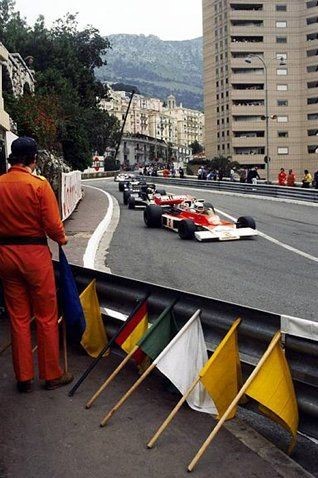
Monaco GP. Motorsport photography.
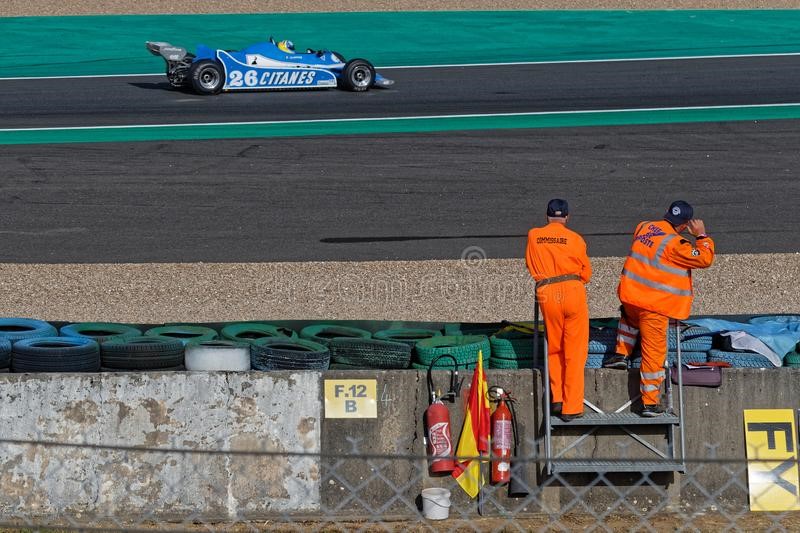
French Historic Grand Prix, Magny Cours, France, 05 July 2019.
Times change. The perception of risk has changed, safety beyond all limits. With the result that today there is no risk of anything, even when there is no risk.
Marshals stationary, waiting in the refuge
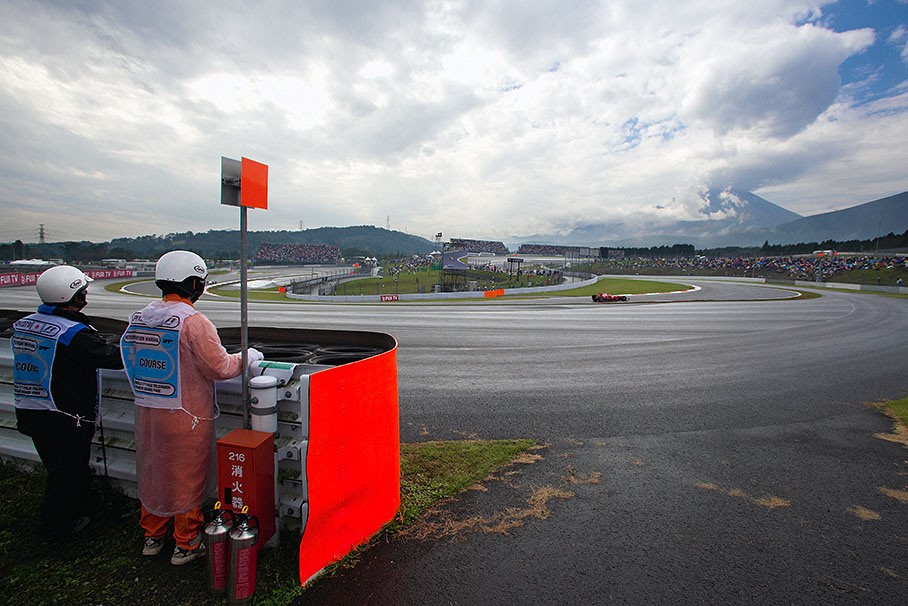
Marshals stay alert at the hairpin, Mount Fuji 2008. Photo by Rainer Schlegelmilch.
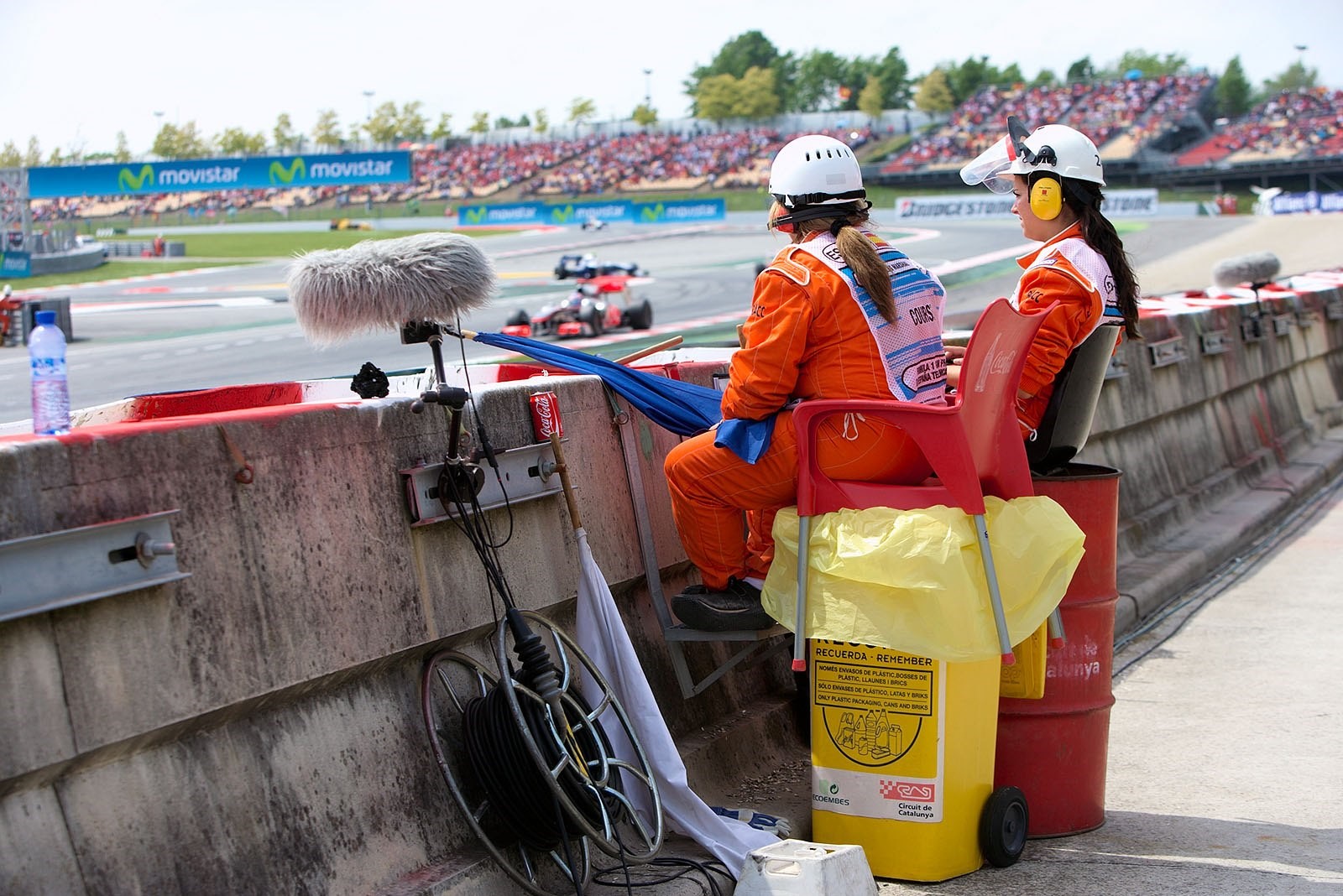
Marshals at Barcelona in May 2010. Photo by Rainer Schlegelmilch.
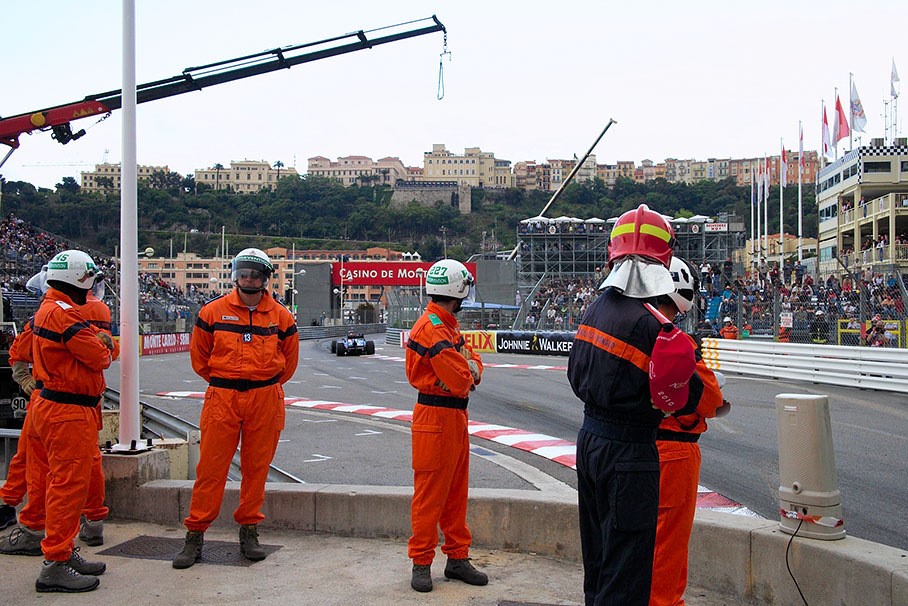
Marshals take care at the Piscine chicane, Monaco, June 2010. Photo by Rainer Schlegelmilch.
The marshals are always passionate volunteers but they do not leave their "refuge" even if a car stops a few meters from their position, outside the trajectory and it would be enough to push it for a few meters to shelter it behind the protection barriers.
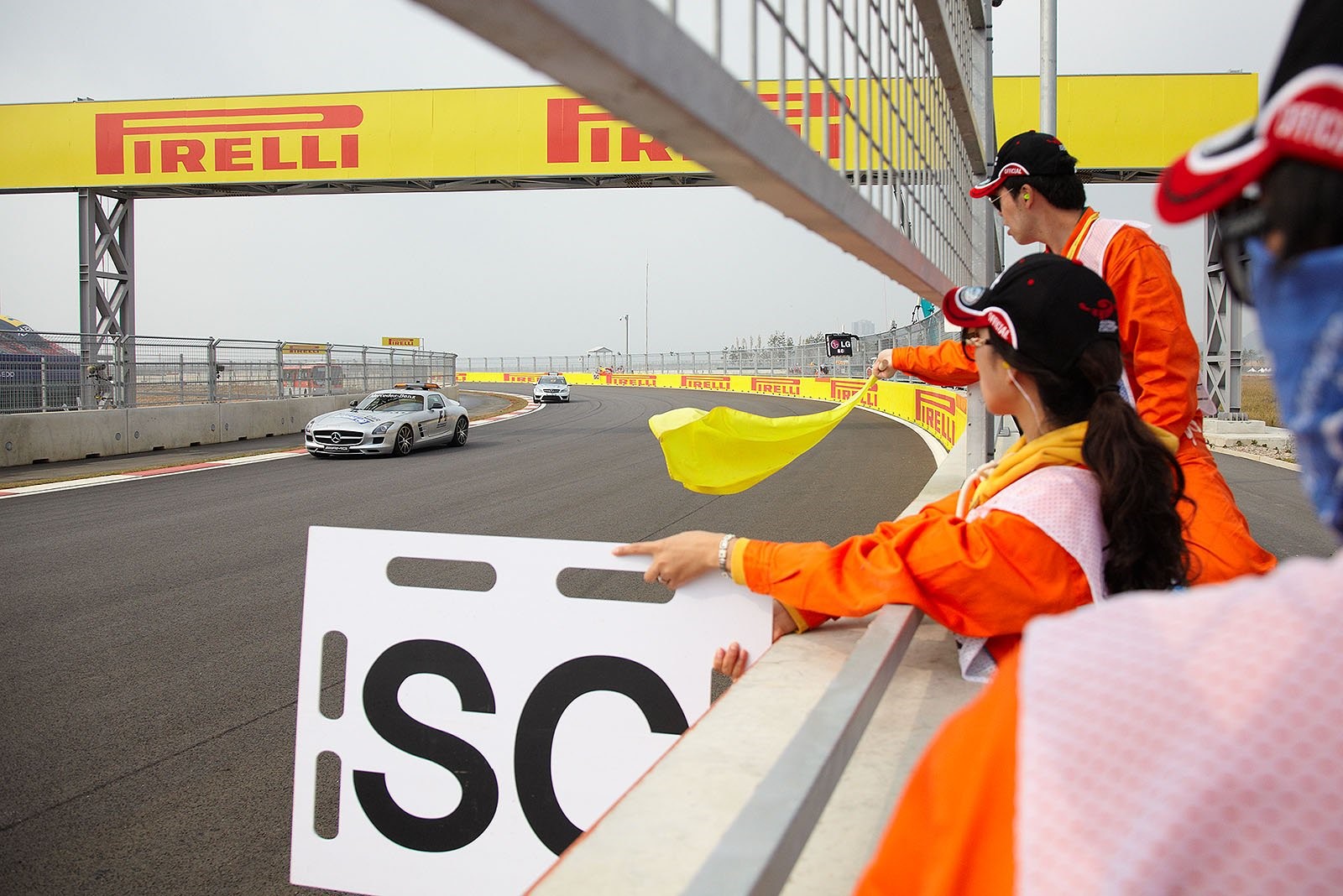
The safety car on tour for track inspection 15 minutes before practice session at Yeongam, South Korea, in 2011. Photo by Rainer Schlegelmilch.
No, you have to wait for the safety car or the insane virtual safety car. Or the cars are moved with the deadly tractors that killed Julies Bianchi. If we look at the images of the Grands Prix of the past, the track was dotted with cars stopped at the edges of it. Zero security. For heaven's sake, we are certainly not asking to go back to those times but, as always, we have reached the opposite excess and we forgot the healthy "middle ground".
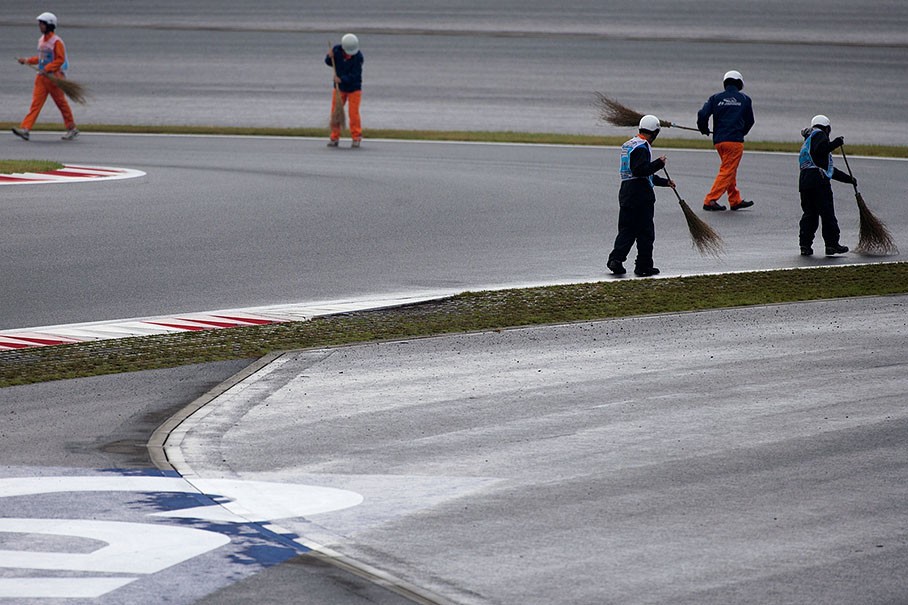
Between the sessions, marshals clean the track from rubber and dirt at Mount Fuji in 2008. Photo by Rainer Schlegelmilch.
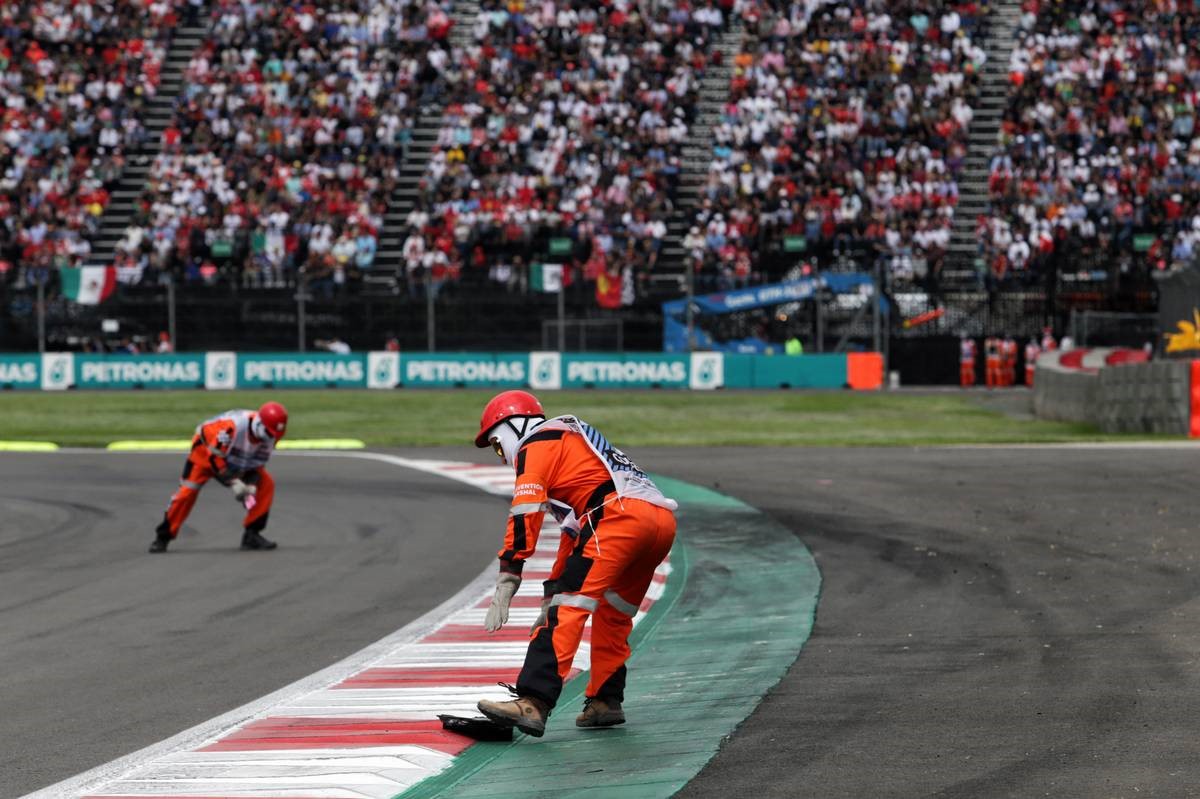
Marshals at the 2018 Mexican Grand Prix.
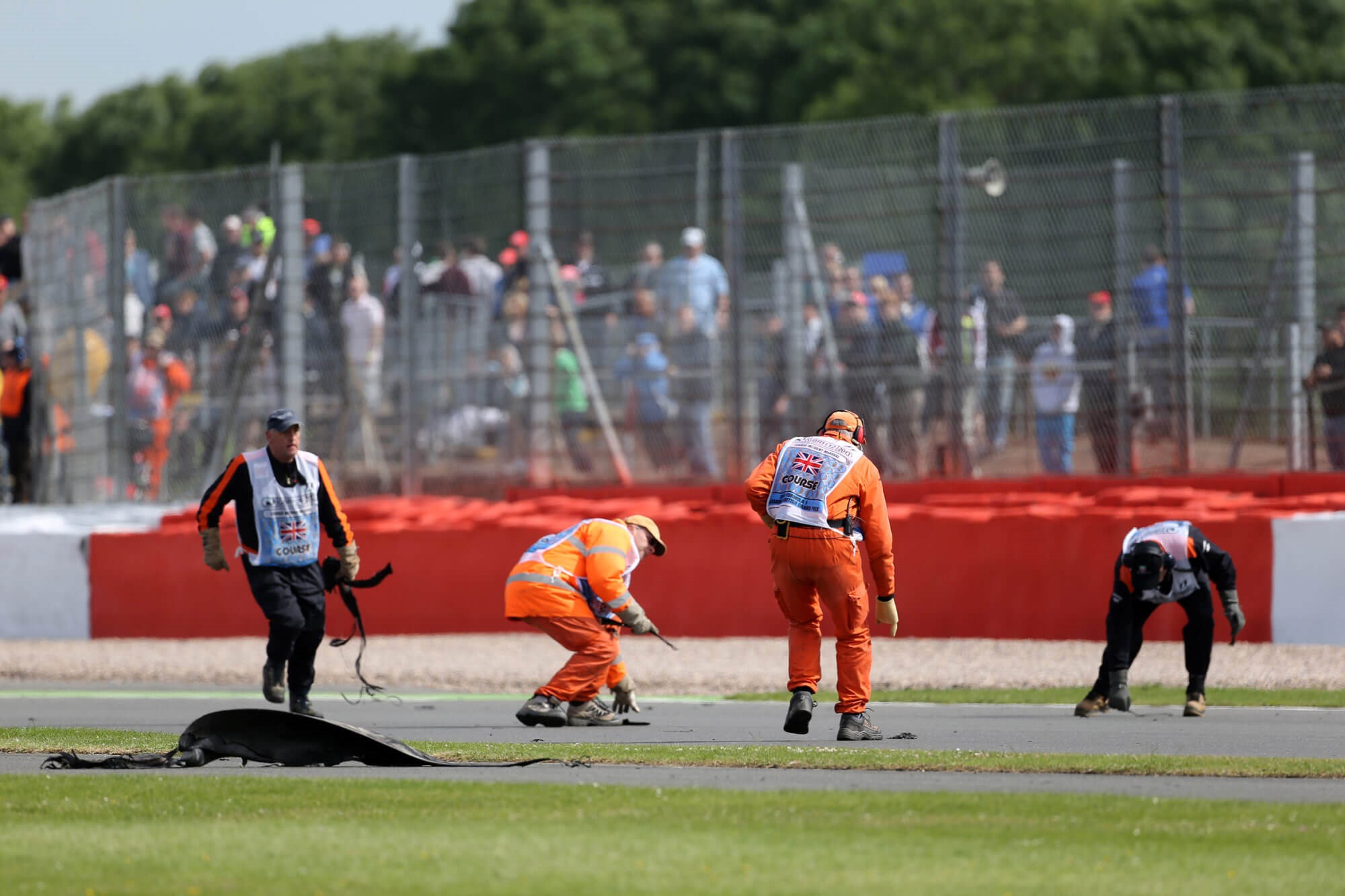
Race marshals in Silverstone.
But then, are we so sure that a crane on the track is better than a car parked outside the trajectory? And then there were once the yellow flags. Respected by the drivers because there was risk, there was also respect for those men who risked their lives out of passion to put themselves at the drivers’ service. Today there are still the yellow flags but often the drivers do not respect them, also counting on the uncertainty of the rules: was there the yellow flag? Yes, but the light panel was green.
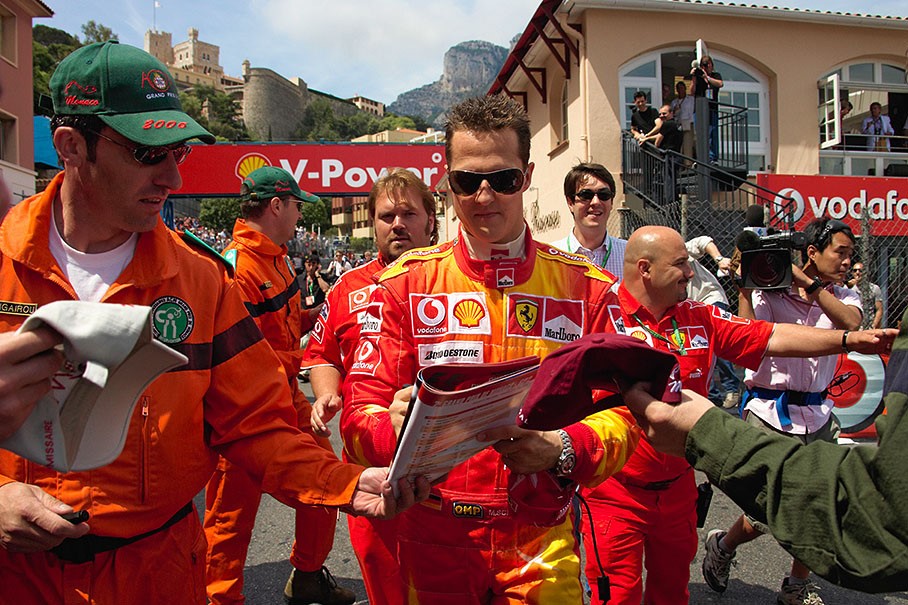
No, not a marshal with a defect washing machine, it is Michael Schumacher on his way to paddock at Monaco in July 2006. Photo by Rainer Schlegelmilch.
Technology has "killed" passion
The excess of technology, in this field too, instead of making things easier has complicated them: the marshal waves the yellow flag, the panel says green light. How do they coordinate themselves? I don’t know if anyone is able to explain it to me, I await clarification. Yet, in the mental confusion that now seems to have invested the judging bodies of the FIA regarding the rules, these last are applied with the utmost discretion which in the end is equivalent to arbitration.
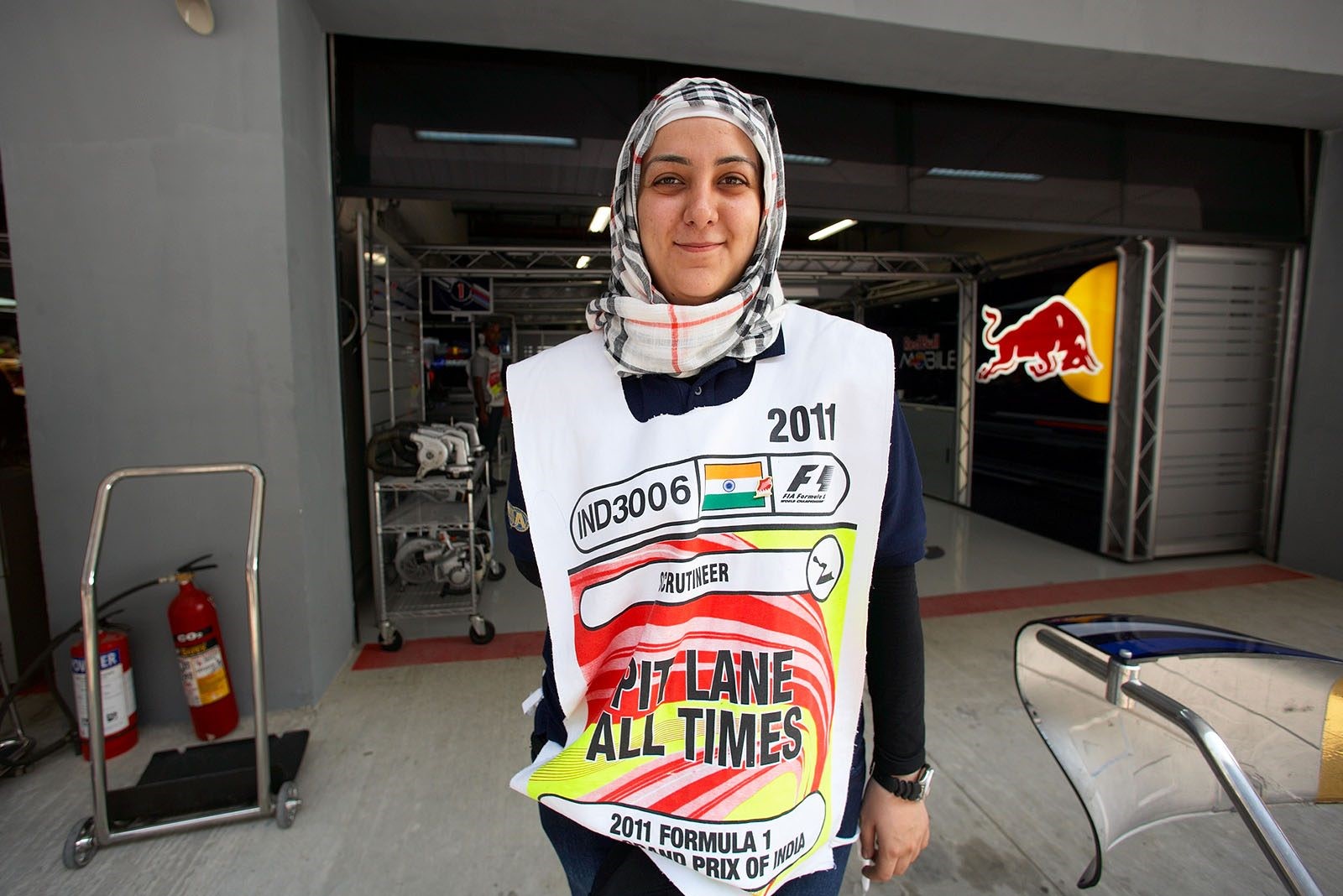
A friendly pit lane marshal guards the Red Bull pits at New Delhi, India in 2011. Photo by Rainer Schlegelmilch.
1970s bowls rules
We are amazed that all this is accepted by large car manufacturers that invest hundreds of millions of Euros only to be victims of a regulatory management that could not even exist in a bowls club for the over seventy years old tournament. The solution is not difficult if, but far be it from it to happen, a minimum of logic is applied: the signals of the flags are valid, the luminous panels being only to integrate them and should in any case be operated by the marshals who, being they and not the race direction, have the real pulse of the situation.
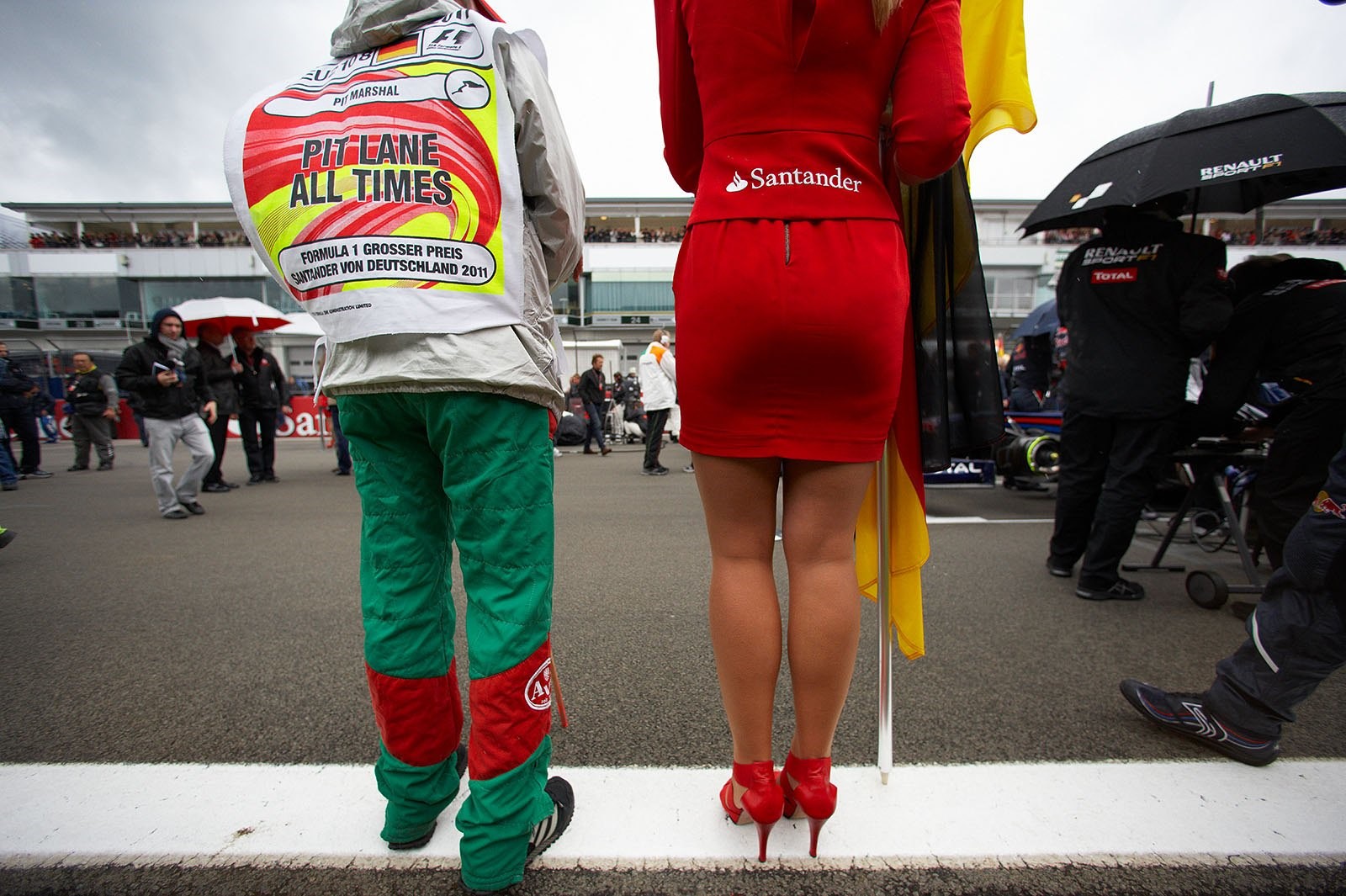
Standing on the strip at Nuerburgring in October 2011. Photo by Rainer Schlegelmilch.
Insane interventions bypassing the marshals
No risk of misunderstandings because it’s the same station of the race commissioners that activates the panel. The race direction is responsible only for the safety car, but in situations of real danger, not like the ridiculous safety car of Monza 2020, with the car stopped completely outside the trajectory at the entrance to the pit lane and via the virtual safety car, completely useless if a double yellow flag, waved before the offending point, was respected by the drivers with a real slowdown (and here yes, technology can help to see who really slows down) in the section between the double yellow flag and the next green flag.
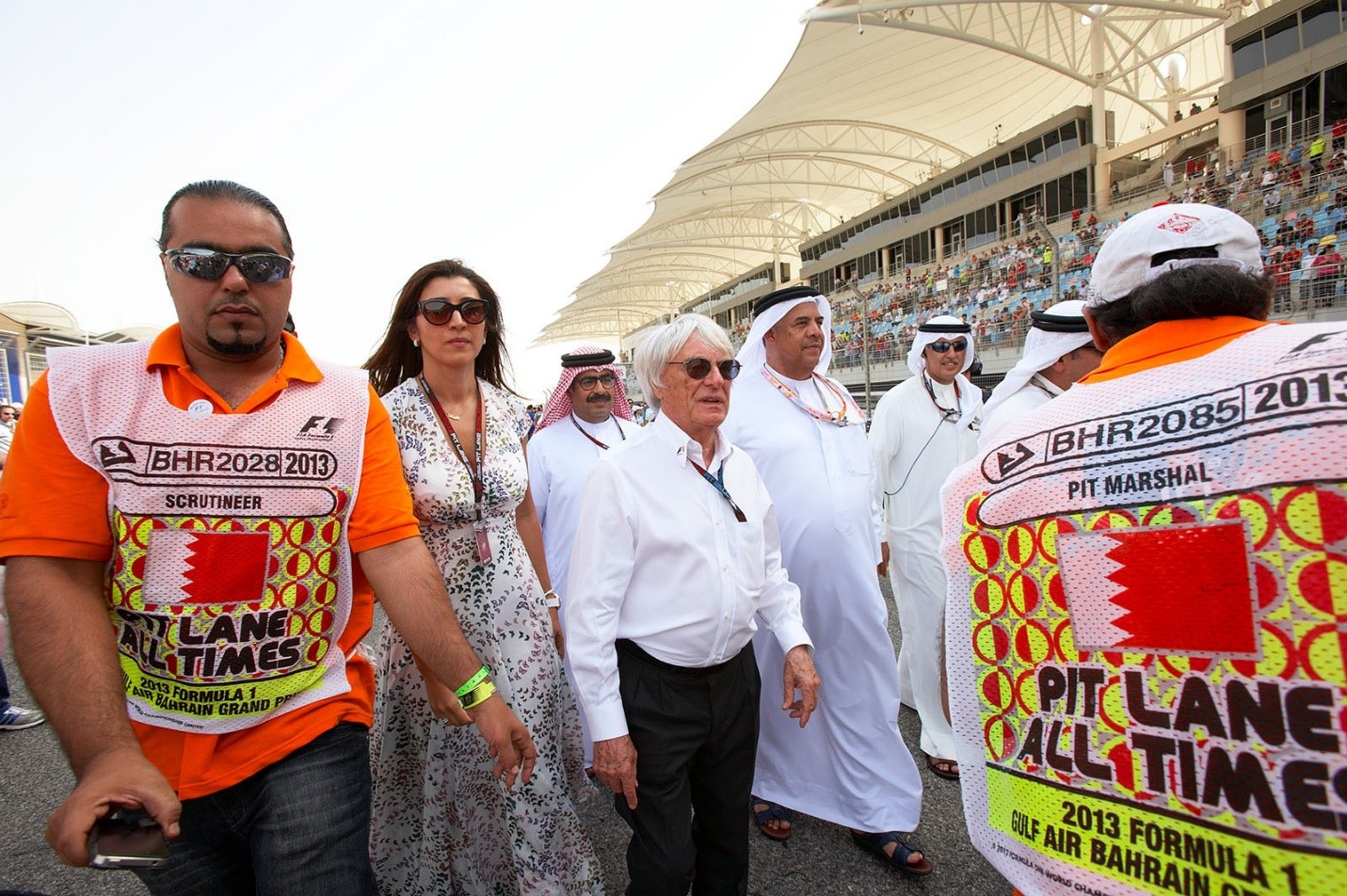
Formula One group CEO Bernie Ecclestone walks the grid with his wife Fabiana Flosi and the Bahrainian rulers at Sakhir, Bahrain, in 2013. Photo by Rainer Schlegelmilch.
Formula 1 bad example for the other categories.
And then heavy penalties, up to disqualification from the race, for those who don’t respect the regulations, which now seems to be the rule. It happened like this in Spa with poor Hubert and again this year with Rigon and, on Sunday again, in the tourism race in Macao. And this indiscipline is even more accentuated in the minor formulas. I think it's time to use an iron fist to put an end to this bad habit, in order to see the commissioners really do their job without risking and without necessarily let virtual safety cars be in action or safety cars come out.
Videos



Comments
Authorize to comment